
LOCAL AUTHORITY BUIL DING& MA INT ENA NCE
HOUSING & REGENERATION
FIRE PROTECTION & SECURITY
ROAD TO ZERO CARBON
WATER MANAGEMENT
REDUCING PLASTIC IN CONSTRUCTION
WORKING TOGETHER TO DELIVER NET ZERO
How Together Housing is leading the drive for Net Zero in the North of England
SHOW PREVIEW Europe’s largest housing festival returns to Manchester Central in June
New series: Changing Streams explores how we can reduce plastic dependence in the construction industry THE



LABMONLINE CO UK
LEADING MAGAZINE
LOCAL AUTHORITY
SPECIFIERS
FOR
AND HOUSING ASSOCIATION
2024
MAY/JUNE

CONTeNTS
REGULARS
5 Comment Social Change
6 News
NHBC local authority insights collection APM Golden Thread Report 2024
Pagabo £1 6bn Decarbonisation Solutions
Framework HA stock transfer
7 Roof Upgrade Insights with A Proctor Group
Advice on choosing roofing underlays for retrofit projects
8 Project Update
Platform Housing Group £20m apartment scheme in Manchester Abri’s 100% affordable housing development tops out in Reading Onward Homes appoints
Sustainable Building Services for retrofit project in Oldham
10 Industry Report
Mears Group launches its first Decarbonisation Report Warmer, healthier homes
SHOW PREVIEW
12 Housing on the Agenda
LABM takes a look at what’s on the agenda for Housing 2024 in Manchester in June
14 Retrofit Skills Challenge in association with The Retrofit Academy
How local authorities and social housing providers can address their skills gaps
15 Reducing Plastic in Construction in association with Changing Streams and the University of Liverpool
The first in a new series of articles looking at how the construction industry can reduce its dependence on plastic



16 Supporting Councils to Invest in New Homes
Willmott Dixon offers advice on how cashstrapped councils facing Section 114 can still invest in towns and cities
18 Making Sustainable Paint Choices
The role that paint can play in sustainable housing upgrades
20 OSB in Timber Frame Construction
The benefits of using OSB panels in timber frame construction
22 ROUND-UP

24 Building fire-rated Breather
Membranes into Safety Strategies
What specifiers should consider when choosing fire-rated breather membranes
29 Vital role of Building Control
The essential role of Registered Building Control Inspectors on fire safety projects
33 How Frameworks Support with Fire Safety
LHC discusses how frameworks support social housing providers to ensure compliance with building safety legislation
36 ROUND-UP

Working Together to Deliver Net
40 Decarbonising District Heating in Southwark
How water source heat pumps are providing low carbon heat to three South London housing estates
43 Mapping the Future of Timber in Construction
The Timber in Construction Policy Roadmap and increasing sustainable timber use in construction

46 Staying in the Loop with Water Circularity Is it time to reconsider the ways in which we store, manage, and reuse water?
48 Water Qualitatively and Quantitively
How ‘good’ SuDS addresses water quality as much as water quantity
ROUND-UP
M A y / J u N e 2 0 2 4 L A B M I 3
ROAD TO ZERO CARBON A guide to what’s on at Housing 2024 | 12 The Timber
Policy Roadmap’s role in boosting the use of
products in construction | 43 HOUSING & REGENERATION 3 8
Zero T o g e t h e r H o u s i n g d i s c u s s e s i t s j o u r n e y t o N e t Z e r o a n d d e c a r b o n i s i n g i t s e x i s t i n g h o m e s
in Construction
timber
50
May/June 2024 Vol 40 No 3 FIRE PROTECTION & SECURITY WATER MANAGEMENT

Editor Claire Clutten
labm@hamerville co uk
Advertisement Manager
Dave Jones dave@hamerville co uk
Group Advertising Manager Craig Jowsey
Digital Manager
Jasmine Smith JSmith@hamerville co uk
Digital Assistant
Toby Richardson trichardson@hamerville co uk
Design
Adeel Qadri
Production Assistant Claire Swendell
Group Production Manager Carol Padgett
Circulation Manager
Kirstie Day
Printed by Stephens & George
Published by
Hamerville Media Group
Regal House, Regal Way, Watford, Herts WD24 4YF 01923 237799

Email: labm@hamerville co uk © 2024
Subscriptions to LABM are available at the following rates: UK: 1 year £30 00 post paid Europe and Overseas: 1 year £50 00 post paid
Airmail: 1 year £65 00 post paid

12,224 (1 July 2022 30 June 2023)
To be removed from LABM’s circulation please call 01923 237799 or email: circulation@hamerville co uk
At the end of April, the Department for Levelling Up, Housing & Communities handed over new powers to local authorities to be able to buy cheaper land for ‘development through compulsory purchase orders to help build thousands more social and affordable homes’
Levelling Up Minister Jacob Young believes the announcement “will act as a catalyst for investment in our towns and cities and drive much needed regeneration in communities across the country” Currently, the inescapable fact is that not enough new homes are being built, with demand far outstripping supply, and a disproportionately high need for more genuinely affordable and social housing Acknowledging the need to build more homes, Jacob Young MP said these changes will help unlock “ more sites for affordable and social housing, as well as supporting jobs and growing the economy ”
Any initiatives that support the creation of more affordable and social housing are to be welcomed, particularly when you consider, “England is losing social housing much faster than it is being built and the losses are mounting up, ” says Dan Usher, Economics Director at Marrons
The socio-economic experts at Marrons released their latest research findings in early May, which paint a bleak picture for social housing, highlighting a deepening chasm between the north and south of England
According to the planning consultancy’s 2040 Housing Report, ‘only 16% of the 295,197 social rent properties owned by local authorities and registered providers sold or demolished nationally between 2015/16 and 2021/22 have been replaced’
The research suggests that if this situation continues at the current level, ‘it will result in a net loss of 385,887 homes by 2040’, with 13 of the top 20 local authority areas expected to see the biggest losses situated in the north of England and the remaining seven being Greater London Boroughs
Kate Henderson, Chief Executive of the National Housing Federation, welcomes the
COVER STORY:
Government’s decision to give councils new powers, enabling them “to buy cheaper land through Compulsory Purchase Orders without paying ‘hope value”, saying it “will allow them to build more of the desperately needed affordable homes the country needs, in the right places for the people who need it most”
These new powers will enable local authorities “to overcome financial and viability barriers to delivering housing”, says Lawrence Turner, Director at Boyer, however he says, “CPO is a lengthy and costly process, and many local authorities will lack the resources to do so ”
“ The socio-economic exper ts at Marrons released their latest research findings in ear ly May...”
These changes introduced by government in isolation will not fix the housing crisis, or deliver the volume of new social housing desperately needed to turnaround the growing deficit, they “must sit alongside wider reforms to planning policy which should form part of a nationally coordinated fully funded long-term plan for housing,” says Kate Henderson
For years the Government has been heavily focused on increasing home ownership across the country, to the detriment of social housing, so it’s hugely positive to see greater powers being devolved to councils specifically targeted at boosting the supply of affordable and social housing But if we are to reverse the current trend and projected net social housing loss predicted in Marron’s recent report, government needs to do significantly more, especially as so far it’s woefully failed to meet its self-imposed 300,000 homes a year target We need more new homes built in the right places, which take into account vital socio-economic factors and meet the needs of local people, and social housing has to be a major part of the mix

MEDITE SMARTPLY’s OSB range was specified for the award-winning Goldsmith Street Passivhaus housing scheme in Norwich Find out more about the project and benefits of OSB panels on page 20




M A Y / J U N E 2 0 2 4 L A B M I 5 EDITOR’S COMMENT
MON N U OW P E g h e C E O N T Z H g H d N Z h g C NG N CON N N h d h d M / NE 024 OCAL HOR Y D NG & MA NTENANC
S o c i a l c h a n g e
IN BRIEF NEWS

Orbit’s social value certified by HACT The housing provider has been working in partnership with HACT to ensure it continues to demonstrate best practice in social value and as part of this, invited HACT to undertake a review of its current approaches to data collection and social value calculations
The audit confirmed that Orbit had met high data quality standards and correctly calculated the social value of projects and activities delivered in the financial years 2020-2021 and 2021-2022 totalling £42 7m in social value
Afzal Ismail, Group Executive Director for Orbit Corporate Services, comments: “We’re delighted to achieve this certification from HACT, which reflects Orbit’s strong commitment to deliver £100m in social value by 2025 and our ability to accurately report to our lenders, ABN-AMRO and Barclays for part of our two sustainability-linked loans ”
Hightown completes stock transfer Hightown Housing Association has completed a stock transfer of 51 supported housing units in Hertfordshire from Notting Hill Genesis The supported housing units are for people with a range of learning disabilities located in Bushey, Hemel Hempstead, Welwyn Garden City, Hitchin and Letchworth Garden City Hightown staff already provide support for residents at 23 of the properties
David Bogle, Hightown's Chief Executive, says: "We look forward to providing high-quality landlord services to our residents in these homes, many of which already receive high-quality support from Hightown staff ”
Independent provider of warranty and insurance for new-build homes, NHBC’s latest book brings together some of the leaders of local authority development and regeneration to share their thoughts on the sector
Available in print and to download, Built On insights a collection of industry insights from leaders in local authority development, has been produced to highlight the important work undertaken by local authorities It raises questions about the viability of local authority housing in its current form and celebrates the dedicated professionals delivering quality housing in challenging circumstances
Examining the current state of local authority residential development and the difficulties faced by many councils, this book covers everything from regeneration and retrofitting to partnership working and methods of modern construction (MMC) It also gives insight into the motivations of its contributors; from personal backgrounds and early careers, right through to their hopes for the future, this publication portrays the people, as well as the developments they lead
Professor Janice Morphet of the Bartlett School of Planning at University
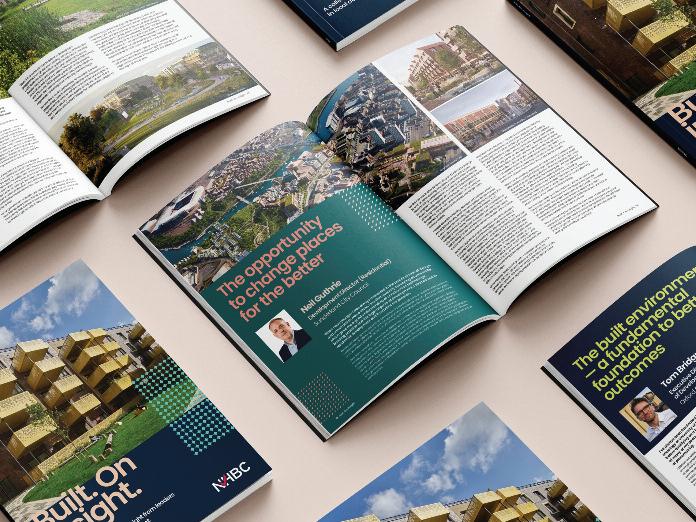
College London authors the collection’s introduction, followed by contributors helping deliver much needed affordable housing, including Shahi Islam, Director of Affordable Housing at Homes England Contributors from around England are featured in this first edition, with viewpoints from a variety of different regions and areas showcased Andrew Milsom, Sector Lead for Local Authorities at NHBC comments: “Local authority housing is part of the fabric of modern society and this collection of insights celebrates many of those who have contributed to its successes ”
Built On insights a collection of industry insights from leaders in housing association development is available to download here www.rdr.link/lar001
APM Golden Thread Report 2024
According to the Golden Thread Report 2024, commissioned by the Association for Project Management (APM) and conducted by PwC Research, the local government sector of the project management profession has grown to contribute £6 18bn of annual gross value added (GVA) to the UK economy
Overall, the project management profession now contributes to the UK economy £186 8bn of GVA a key measure of economic output and productivity This represents a growth of 19% from £156 5bn in 2019

credited for demonstrating the importance of effective project management to ensure successful delivery of large-scale events


Factors behind the growth highlighted by the report include an increasing recognition of the need for effective programme management and transformation across all sectors including local government, while London 2012 was
Professor Adam Boddison OBE, Chief Executive of APM, says: “Our report deepens the view that our profession is the most vital ‘golden thread’ running through all sectors of the economy ”
To view the Golden Thread 2024 Report and case studies, visit www.rdr.link/lar002
H B C l a u n c h e s l o c a l a u t h o r i t i e s i n s i g h t s c o l l e c t i o n
Hightown's head office in Hemel Hempstead
N

£1.6bn decarbonisation framework



Pagabo has announced the 56 suppliers appointed to its second £1 6bn Decarbonisation Solutions Framework, including Morgan Sindall, Kier and Willmott Dixon
The National framework provider recently launched its healthcare specific decarbonisation framework, while this latest instalment will support public sector organisations completing building works in all other sectors
Kingston upon Hull City Council (HCC) is serving as the contracting authority for the framework, which will run for four years The suppliers appointed can provide a complete business solution, allowing clients to go directly to main contractors to undertake retrofit assessments, work up costs, self-deliver or bring in supply chain partners to deliver schemes, while serving as a single point of contact
Typical projects may include but are not limited to installation of specialist heating, cooling and ventilation systems, installation of renewable energy sources, fabric upgrades, installation of energy saving lighting, and replacement of inefficient glazing
The framework has four value-banded lots, applicable to the 12 geographical regions, giving a total of 48 sub-lots
l Lot 1 – up to £1m
l Lot 2 - £1m to £5m
l Lot 3 - £5m to £15m
l Lot 4 - £15m+
Jason Stapley, Chief Procurement Officer at Pagabo, says: “This version, with Kingston upon Hull City Council as the contracting authority, includes 32 SMEs which is more than half of the total number of suppliers appointment With the growing focus on the role decarbonisation has to play in working towards and meeting net zero goals, we know that this framework and its healthcare sister offering will be well utilised by clients, helping them to meet their individual goals while working towards bigger picture goals at the same time ”
More details and full list of suppliers here www.rdr.link/lar003
Choosing a roof underlay for retrofit projects


Installing loft insulation is a relatively easy retrofit measure, and householders might even consider doing it themselves. However any roof upgrades should also consider the condition of the roofing system, says A Proctor Group, as roof coverings and underlays need to be replaced during a building’s useful life.
What to consider when making improvements to pitched roofs Is the roof underlay a traditional high-resistance (HR) membrane, like bitumen felt? Does it need replacing?
Is it a more modern low-resistance (LR) membrane? Complete replacement may not be needed But it is also likely to be an airtight LR membrane, allowing vapour diffusion without the additional benefit of air passing through it
Assessing existing ventilation provision is essential Roof space ventilation might be at the eaves only, or at the eaves and ridge
The effect of loft insulation on the roof space
Typical loft insulation products are vapour permeable, so internal moisture can enter the roof space Making loft insulation thicker reduces the temperature of the roof space, and colder air holds less moisture Condensation in the roof space becomes more likely, even if the underlay is a (LR, airtight) ‘breather membrane’
Effective roof ventilation is essential for removing moisture vapour, but an issue with upgrading loft insulation is whether it can be installed without blocking existing eaves ventilation
Proctor Air: an air permeable LR membrane ideal for retrofit projects
When the time comes to replace a building’s existing roof system whether alongside insulation upgrades or not it makes sense to prepare for the future Proctor Air helps to do just that
The next generation membrane permits the passage of both air and moisture vapour through the roof construction, providing a more uniform flow of air than normal vents Condensation risk in the roof space is therefore removed, and insulation can be installed into the eaves with no risk of blocking ventilation
n For more information visit www rdr link/lar004 Roof Upgrade
Jason Stapley, Chief Procurement Officer at Pagabo
M A Y / J U N E 2 0 2 4 L A B M I 7
Insights with
Great Places Housing Group starts work on £20m apar tment scheme
The new nine-storey residential development, at Laystall Street just off Great Ancoats Street in Manchester city centre, is being delivered in partnership with eric Wright Construction and partfunded by Homes england and Greater Manchester Combined Authority’s Brownfield Housing Fund It will provide 89 one- and two-bed apartments available for Rent to Buy and Social Rent
The development is the second project to commence work at the site following Manchester-based developer, McCauls’ transformation of the Grade II-listed Armitage Showroom into 5,000 sq ft of high-quality office space McCauls are also planning to create a small residential element adjacent designed by OMI Architects, on the corner of Laystall Street and Pigeon Street
Commenting on the start of the project, nick Gornall, Director of Development at Great Places Housing Group, says: “We’re delighted to be starting work at Laystall Street,

which will provide much-needed affordable accommodation in central Manchester Laystall Street is an excellent location, and we look forward to working together again with eric Wright to deliver its transformation The project will breathe new life into this part of the city centre and reinforces our continued commitment to the delivery of affordable homes across Manchester ”
jeremy Hartley, Chief executive Officer at eric Wright Group, adds: “Our Laystall Street project with Great Places builds on our successful
collaboration at Ancoats Dispensary and we are looking forward to partnering with them again Our construction team is committed to delivering excellence, and we look forward to seeing this development bring more high quality, affordable housing to the community in this part of Manchester
“As with Ancoats Dispensary, we will again be creating jobs, working with the local supply chain and offering work experience opportunities and apprenticeships ” Work is expected to complete in early 2026
PROjeCT uPDATe neWS:
8 I L A B M M A y / j u n e 2 0 2 4
100% affordable development in Reading
The construction of 40 new affordable homes on Caversham Road in Reading has reached a major milestone with ‘topping out’ being achieved Mayor of Reading, Cllr Tony Page, and local Abbey ward councillors


Energy efficiency improvements in Oldham

Karen Rowland and Mohammed Ayub, attended to mark the occasion as the building has reached its highest point
The homes, which will be available for affordable rent and offer a combination of one-, twoand three-bedroom apartments, are being built by Abri’s inhouse construction team and are expected to be ready for
the first residents to move in by March 2025
John Kelly, Production Director at Abri, says: “We’re making good progress with these new apartments which will make a real difference to the community By using our own inhouse team we have full control of the quality and when they’re finished, we’ll have homes that people will feel proud to live in ”
Working with consultant Michael Dyson Associates, Onward has appointed Sustainable Building Services (SBS), a contractor that specialises in retrofit and net zero solutions, to deliver energy-efficiency measures to 47 homes in Oldham Onward secured £551,000 in funding for the scheme from a share of £37m awarded to the Greater Manchester Combined Authority from the Government’s Social Housing Decarbonisation Fund (SHDF) Onward is investing a further £1 61m to support the project, making the total project value over £2m
SBS will install new windows and doors, positive input ventilation, as well as loft and wall insulation to help make Onward’s homes warmer, quieter, and more comfortable These measures will help improve the energy efficiency of the homes that currently have an Energy Performance Certificate (EPC) below Band C As part of the contract, SBS will invest £15,000 of social value back into the local community through local groups and projects Michael Dyson Associates is providing a range of consultancy services on the project, including Retrofit Assessor, Co-ordinator, Designer and Contract Administrator
 Gavin Board, John Kelly, Mayor Tony Page, Cllr Mohammed Ayub, Cllr Karen Rowland and Mandeep Dhadwal
Project partners on site
Gavin Board, John Kelly, Mayor Tony Page, Cllr Mohammed Ayub, Cllr Karen Rowland and Mandeep Dhadwal
Project partners on site
U K h o u s i n g n e t z e r o o p p o r t u n i t i e s a n d c h a l l e n g e s
Mears Group has launched its first Decarbonisation Report, which lays out the scale of the opportunity and challenge facing the housing sector as it works towards reaching the UK’s net zero targets.
Building on its extensive experience of retrofitting homes to make them more energyefficient, the report, Warmer, healthier homes domestic retrofit a net zero opportunity, recognises that while there has been some progress, the industry is behind where it needs to be in its net zero journey
It highlights some of the progress that’s been made, such as the Social Housing Decarbonisation Fund (SHDF), which has proven to be a major catalyst for change It also celebrates the emergence of new forums including the National Home Decarbonisation Group, which Mears is a founding member of, as showing willingness across the industry to work together
“ By wor king colla boratively, we can build a future w here ever yone has access to safe, afforda ble housing that goes some way to achieving our net zero ambitions as a countr y.”
The report discusses the scale of opportunity which retrofitting brings in terms of jobs With estimates that the retrofit sector will require almost 500,000 trained professionals to deliver housing targets, there is scope for people to develop careers in this area.
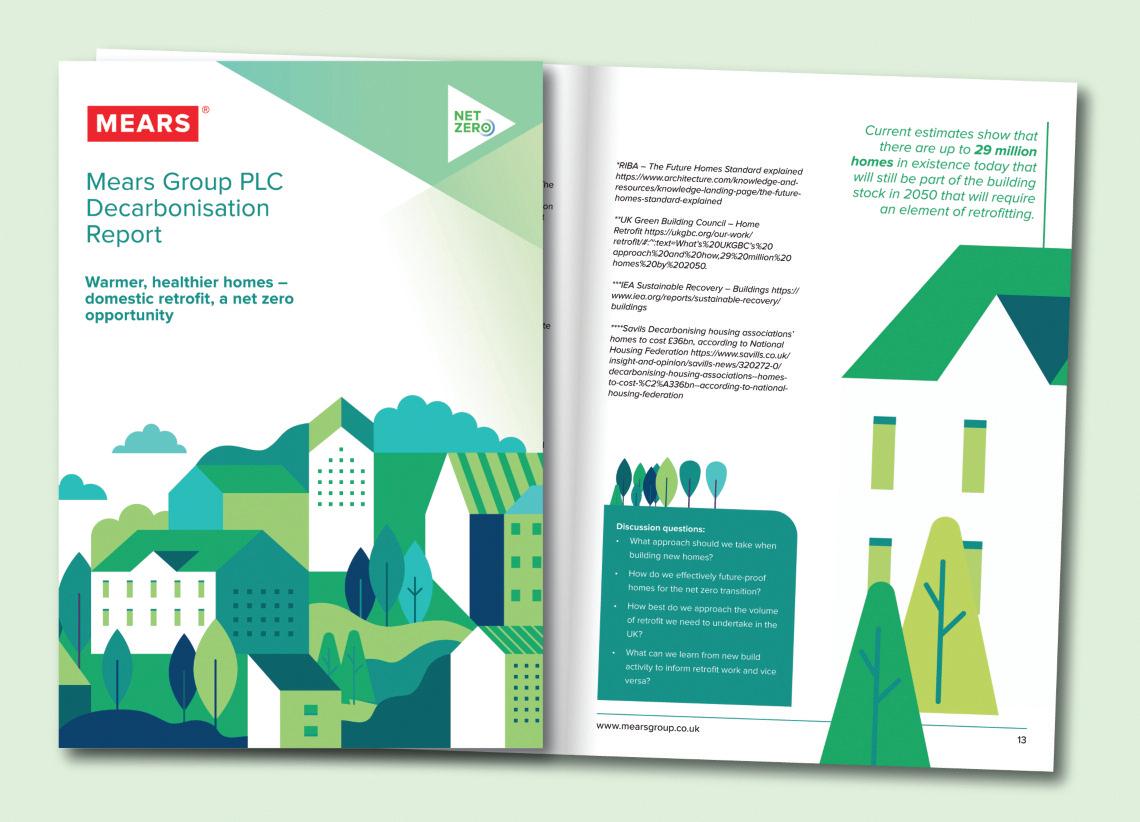
But, with an ageing workforce and ongoing skills shortages, it is vital that the benefits of joining the sector are clearly communicated and that the industry develops clear succession plans to manage the transition across the workforce
The report also addresses the importance of collaboration across the sector and with government It recognises that given the number of properties which need to be retrofitted, estimated to be up to 29 million homes, long-term policy support is required, along with clear regulations and standards
To meet these massive targets, for both retrofit and new housing, the sector must come together and share knowledge, experience and technology
The report puts forward 12 recommendations, which include engaging with tenants by focusing more on their needs, creating new funding models, making retrofit and social housing more appealing as a career choice, and placing greater emphasis on the social value of retrofit.
Collaborative working
Lucas Critchley, Chief Executive Officer of Mears Group, says: “We know that we cannot reach net zero without decarbonising the UK’s housing stock,
and as a sector we all need to work together to meet this goal. Our position as one of the UK’s leading and most trusted providers of specialist housing services means we have a unique perspective on the challenges the sector is facing We also know that there is a massive opportunity for industry to make a real difference, but we must act now to embrace it
“We are pleased to launch this report which builds on our own experience and wider sector trends to look at what industry needs to do to ensure that the transition is inclusive, and that the benefits are felt by everyone
“By working collaboratively, we can build a future where everyone has access to safe, affordable housing that goes some way to achieving our net zero ambitions as a country ”
The report’s 12 recommendations are aimed at helping the sector meet the goal of ensuring the UK has healthier, warmer, better ventilated homes, which support the country’s net zero goals

n The full report can be found here www.rdr.link/lar005
INDUSTRY REPORT: WARMER, HEALTHIER HOMES
1 0 I L A B M M A Y / J U N E 2 0 2 4



Europe’s largest housing festival retur ns to Manchester this June with a packed programme of events, conference sessions, lear ning, debate and networking opportunities for key stakeholders in the sector. Here, LABM takes a look at what visitors can expect from this year’s show
H o u s i n g o n t h e a g e n d a
Ocean Media Group has announced the visitor agenda for Housing 2024, taking place on 25-27th June at Manchester Central Don't miss out on your chance to collaborate with 9,000+ sector peers, learn from 350+ speakers and 150+ hours of CPD across six stages on the showfloor
Session highlights include:
l Co-production and how to achieve meaningful power sharing
l Awaab's Law: what are the implications for landlords and tenants?
l Integrating retrofit within strategic asset management
l Managing the impact of the temporary accommodation crisis
l How will Artificial Intelligence transform the resident experience?
l Minimum energy efficiency standards: improving health outcomes through decarbonisation
l How can housing move from "not racist" to anti-racist?
l The impact of furniture poverty on tenants' lives and what we can do about it
l Where does the climate crisis sit on the political agenda?
Why visit
With a visitor pass you will have the opportunity to access expert-led content including:
l The Tenant and Resident Engagement stage a dedicated stage on the culture change needed to put tenants at the heart of housing
l The Unlock Net Zero stage find practical solutions to accelerate your Net Zero journey


l The award-winning Fringe stage involving frank debates on mental health, EDI, the refugee crisis and more
l Pf H Live learn how smart and
SHOW PREVIEW: HOUSING 2024 “ ” L e a r n h o w s m a r t a n d s t r a t e g i c p r o c u r e m e n t c a n d e l i v e r i m m e d i a t e c o s t s a v i n g s a s w e l l i n s i g h t f u l l o n g - t e r m b e n e f i t s .
Mayor of Greater Manchester Andy Burnham speaking at last year’s event


“
” Stay up-to-date with solutions that could help you deliver better quality homes and more efficient ser vices.
strategic procurement can deliver immediate cost savings as well insightful long-term benefits
l The Specialist Housing stream explore the changing needs of housing not just for older and disabled people but for all groups of people with specialist needs
l The Knowledge and Insight stages stay up-to-date with solutions that could help you deliver better quality homes and more efficient services
Networking and industry awards
This year, there are more networking and practical learning opportunities than ever, including:
l Find solutions across the entire supply chain meet 350+ exhibitors in an inspiring exhibition
l Bring learning to life on through the study tours, which give you the opportunity to explore a local and innovative development first-hand Meet the leaders to hear the story of their journey and make connections during the group tour More details will be available soon
l Give back at the Housing Rocks charity fundraiser join up to 900 people for a fun-filled night watching England play their epic final group stage match then get ready for a round of rock-a-oke
l Celebrate success at the Housing Heroes and Women in Housing Awards and acknowledge the individuals and teams who have made a remarkable contribution to the sector
l Recognise those who are leading the way with net zero solutions at the Unlock Net Zero Awards championing progress on the journey to decarbonisation for the UK housing sector and the supply chain that supports it
Housing has something for everyone! #ukhousing #housing2024






M A Y / J U N E 2 0 2 4 L A B M I 1 3
n To see the full visitor agenda visit www.rdr.link/lar006 n Register for your free visitor ticket here www.rdr.link/lar007 Attend conference sessions discussing important industry issues
See the latest innovations and speak to key supply chain partners in the exhibition
Housing offers a great opportunity to network with industry peers
Learn from 350+ speakers
RETROFIT SKILLS CHALLENGE IN
ASSOCIATION WITH


Liverpool City Region scoops top retrofit award
At this year ’ s awards, which took place at the uK’s first national Retrofit Conference, leaders came together to celebrate businesses, local authorities, and individuals who have completed industryleading work to help decarbonise buildings and homes across the uK
To be crowned as this year ’ s winner, Liverpool City Region Combined Authority had to demonstrate how their programme successfully engaged residents in the retrofit process, and how cost efficiency was prioritised without comprising quality
Over the last three years, the Combined Authority has used available government funding to decarbonise over 4,000 social homes within the six boroughs it covers This includes Halton, Knowsley, Liverpool, Sefton, St Helens, and Wirral
Fuel poverty rates
According to the Fuel Poverty Research Library, fuel poverty rates were significantly higher than the national average among the population living in Liverpool On average, 12 7% of a Liverpool household’s income is spent on energy with this rising to 17% among those with a low-income By retrofitting social houses, homes will be able to contain heat more efficiently, allowing for less energy to be used and for money to be saved
Having applied for funding through the Department for energy Security and net Zero, Liverpool City Region Combined
Authority received £28 5m from the Sustainable Warmth Fund to decarbonise 2,355 homes With an impressive delivery record and the region having a high quantity of gas-fuelled homes, the region was allowed to change funding from Home upgrade Grant 1 to Local Authority Delivery 3 As a result, a further 2,849 households could receive improvements
To help make this work possible, Liverpool City Region Combined Authority worked closely with local businesses and contractors, also using funding directed towards skills enhancement in the region to help upskill workers As a result, many employees have received formal retrofit training, lowering the skills gap in the area
Best Local Authority-Led Retrofit Programme
Tracy Gordon, Lead Officer of Housing Partnerships at Liverpool City Region Combined Authority says: “Over the last three years, we have worked incredibly hard on the behalf of our six local authorities to retrofit as many homes as possible for residents, securing more than £100m in total funding to retrofit around 10,000 homes By being recognised as having executed the Best Local Authority-Led Retrofit Programme at The Retrofit Academy Awards, we hope that other local authorities follow in our footsteps to decarbonise their region for their population

“Our journey retrofitting homes hasn’t ended here When the third wave of Social Housing Decarbonisation Funding is made available, we will apply for as much assistance as possible to continue retrofitting the Liverpool City Region By the time of the 2025 national Retrofit Conference, we will have added even more homes to our current total David Pierpoint, CeO at The Retrofit Academy, adds: “Liverpool City



Following the successful completion of their retrofit programme, where over 4,000 residences received sustainable upgrades, Liver pool City Region Combined Authority has been named Best Local AuthorityLed Retrofit Programme at The Retrofit Academy Awards 2024
“By being recognised as having executed the Best Local Author ity-Led Retrofit Programme at The Retrofit Academy Awards , we hope that other local author ities follow in our footsteps to decarbonise their region for their population.”
Region Combined Authority are a shining example of what can be done when you utilise funding to ensure that houses within a region have the necessary sustainable upgrades to help achieve net zero
“The purpose of The Retrofit Academy Awards is to show the industry the fantastic work completed throughout the uK and lead the way for others to do the same Retrofitting homes plays a crucial part in helping to achieve net zero and Liverpool City Region Combined Authority is leading the way on how local authorities can do this ”
n For more information about the Liverpool City Region Combined Authority, visit www.rdr.link/lar008

n For more information about The Retrofit Academy, visit www rdr link/lar009
1 4 I L A B M M A y / j u n e 2 0 2 4
REDUCING PLASTIC IN CONSTRUCTION in association with



Setting the scene —the Challenge of Plastic
Changing Streams was established nearly five years ago to address the growing issue of plastic in the construction environment, to work with industr y players at all levels to reduce dependence on plastic where possible, minimise waste and identify sustainable alter natives. This is the first in a series of ar ticles to explore the issue and the solutions, and to invite you to join us on our jour ney
We all know that plastic waste is a huge problem we see it every day on our streets, in parks and on the beaches, and every time we come home from grocery shopping there are all those plastic containers and film wraps to deal with much publicity has been given to wet wipes blocking sewers with resulting infrastructure damage, and to government initiatives such as banning plastic drinking straws and cotton buds
Important as all of this is, there is much less publicity given to another major use of plastic in the construction industry The sector is second only to packaging in its use of plastic, which has transformed buildings over the last half-century to enable the way we live now Polymerisation and chemical manipulation have allowed the development of a wide range of materials all coming under the broad heading of plastic but these may be rigid or pliable, waterproof, and provide electrical or thermal insulation as well as internal structural components and fillers Textiles from synthetic materials
and paints present huge opportunities in design and interior detailing
However this comes at a cost to the environment and to the ecosystem that we are a part of nearly 10% of fossil fuels extracted are currently used either as raw material or in the production of plastics, a proportion which is likely to increase with the trend to greener energy sources In a ‘business as usual’ scenario, plastic use in construction is projected to reach 193 million metric tonnes by 2060, which will represent the use of at least twice that amount of fossil fuel1,2
Emissions, waste and contamination
Why does this matter? Well, firstly in terms of greenhouse gases, plastics already account for approximately 3 to 8% of current global GHG emissions This number is expected to increase significantly by 2050 if plans to exponentially increase production are realised, with plastics projected to consume 13% or more of earth’s remaining carbon budget (if we are to keep warming below 1 5˚C) 3

Secondly, there are major issues in terms of waste and contamination chemicals as well as polymers Plastics contain not only polymers, but the need to customise for particular applications has resulted in addition of a huge range of chemicals, which make those polymers functional and attractive a recent estimate suggested that there may be as many as 16,000 different chemicals used in plastic production, of which a quarter give rise to concerns about long-term toxicity
This diversity of composition means that discarded plastics are very difficult to dispose of efficiently any skip coming off a construction site will contain plastics of various types from different manufacturers each with an individual chemical footprint This makes recycling extremely complex and costly, with the result that this waste is more often destined for incineration or landfill This results in long-term contamination of soil, and potentially of waterways and the air we breathe at Changing Streams, we are working with key players in the industry to identify how the dependence on plastic in construction may be mitigated In coming issues, we will be inviting you to join us on our journey to reduce unnecessary plastic use and to introduce sustainable alternatives where feasible
1 Global Plastics Outlook: Policy Scenarios to 2060https://www oecd-ilibrary org/sites/aa1edf33en/1/3/2/2/index html?itemId=/content/publication/aa1edf33en& csp =ca738cf5d4f327be3b6fec4af9ce5d12&itemIGO =oecd&itemContentType=book
2 https://www statista com/statistics/282732/globalproduction-of-plastics-since-1950/#:~:text=The%20world wide%20production%20of%20plastics,percent%20from %20the%20previous%20year
3 https://www ciel org/wpcontent/uploads/2023/09/Reducing-Plastic-Production-t o-achieve-Climate-Goals Sept21 V5 pdf
n For more information on Changing Stream’s work visit www.rdr.link/lar010

m a y / j u n e 2 0 2 4 L a B m I 1 5
How can cash-strapped councils facing Section 114 still invest in place? With some councils across the UK facing tough times with their finances, David Atkinson, National Head of Land and Development at Willmott Dixon looks at options to help them continue investing in new homes

Suppor ting councils to invest in new homes
It’s striking that 12 out of the 14 councils that have issued section 114 notices since the Local Government Finance Act became law in 1988 did so after 2018 It underlines the huge challenges facing local authority finance, with those that have issued “bankruptcy” notices unlikely to be last A survey from the Local Government Association found that one in five councils “think it is very or fairly likely that [they] will need to issue a section 114 notice this year or next due to a lack of funding to keep key services running ”1
Currently local authorities spend most of their budget on schools, including special needs, social care and maintaining roads A rise in these commitments, and a squeeze on budgets, has had real consequences
Fears of more defaults are real In fact, just over half of councils have warned they’re likely to issue a section 114 notice
in the next five years 2 As it stands, just 4% of councils are confident in the viability of their finances3 in their present state
How has this happened?
Why are so many councils expecting expenditure to exceed income Councils typically receive funding via three streams council tax, business rates and commercial income Austerity cuts4, generally agreed to have started in the aftermath of the financial crisis in 2010, cut central government funding and grants significantly


As a counter to this, government legislation was modified, freeing up councils to take on bigger, more speculative investments for commercial income For some councils, this was a success purchasing office blocks and similar forms of real estate provided and continues to provide additional income For others however, it was the opposite Hindsight is easy, however at the time many investments in retail, considered traditionally a safe bet, were flattened in terms of revenue by the economic recession, defaults and property not being let
Councils rode out these bruising events by making cuts as necessary As the need to cut became deeper, so the scope and impact of those cuts became more and more profound Crucially, with increases in costs, many councils now see either no or just limited room for manoeuvre
HOUSING & REGENERATION
Willmott Dixon helped accelerate Rotherham Council’s plans for town centre renewal by building 130 homes across three sites
T h e r e a r e p l e n t y o f c h a l l e n g e s t h a t d o n ' t h e l p ; t h e i m p a c t o f i n f l a t i o n h a s s e e n c o u n c i l ’ s r e a l s p e n d i n g p o w e r d r o p 1 2 % l o w e r t h a n i t w a s a d e c a d e a g o N a t i o n a l L i v i n g Wa g e c o n t r i b u t i o n s , p a r t i c u l a r l y p r e v a l e n t i n t h e a d u l t c a r e s e c t o r, w i l l c o s t c o u n c i l s £ 1 1 b n i n a d d i t i o n a l o v e r h e a d s i n 2 0 2 4
David Jackson, National Head of Land and Development at Willmott Dixon

“O n e a re a w h e re t h i rd
p
a
r t i
e s c a n re a l
l
y a d d va l u e
i s t h ro u g h s t ra t e g i c b u s i n e s s
p l a n n i n g a n d a c c e s s i n g
g ra n t f u n d i n g fo r h o u s i n g . ”
homes in a generation Knowing they needed more support and capacity, Rugby asked our team to accelerate the important pre-construction phase We used our expertise in unlocking grant by assisting Rugby in making their first Homes England Affordable Homes Programme 2021-2026 grant application
Don’t sell the family silver
What can be done?
This situation does not mean important local authority housing development has to stop By working in different ways with the private sector, there are innovative solutions to deliver an agenda for place creation For example, Willmott Dixon engages with many councils to get complex regeneration programmes off the ground This can be through producing early-stage feasibility to start the process, completing work ordinarily done by officers who may lack the capacity
One area where third parties can really add value is through strategic business planning and accessing grant funding for housing A good partner can fill this gap, utilising teams of experts in local government to develop viable, market facing plans and access funding that unlocks major projects For example, in Rugby, we supported the Borough Council in developing their first council-built
The result was that work has now started to build 100 affordable homes at Rugby’s Biart Place development This collaboration proved decisive and showed what’s possible by utilising private sector capacity without compromising on control
Similarly, collaboration was key with Rotherham Council, where we accelerated their plans for town centre renewal by building 130 homes across three sites These homes were delivered for affordable rent, shared ownership and market sale
Again, alongside the construction skills, our development team supported Rotherham by sharing knowledge and expertise on the most appropriate market sale typologies and specification, followed by a full wrap around sales and marketing service This included setting up a brand called “The Trilogy Collection”, along with website and marketing materials, sales offices, as well as staffing the show room
The impact was instant Finished a few months ago, two of the three sites are now sold out, with over 120 families living in Rotherham town centre
Another tactic councils can use is asset sales This is often a knee-jerk go-to in times of financial constraint and it can often see authorities forced to dispose of assets at sub-optimal rates It’s also worth remembering that land sales are a onetime deal councils don’t want to be seen to be ‘giving away the family silver’ It is easy and understandable for councils facing financial duress and local pressure to defer much needed investment in place However, the options are there to avoid this, and the resulting financial returns could provide important new sources of income to help balance the books in future financial years
1 Local Government Association, Section 114 fear for almost one in five council leaders and chief executives after cashless Autumn Statement 6th December 2023: www local gov uk/about/news/section-114-fearalmost-1-5-council-leaders-and-chief-executivesafter-cashless-autumn
2 https://www localgovernmentlawyer co uk/ governance/396-governance-news/56580-half-ofcouncils-could-issue-section-114-notice-in-next-fiveyears-amid-surge-in-councils-dipping-into-reservessurvey-shows
3 https://lgiu org/publication/the-state-of-localgovernment-finance-in-england-2024/
4 https://www theguardian com/uknews/2024/jan/29/how-a-decade-of-austerity-hassqueezed-council-budgets-in-england
Further source: https://www instituteforgovernment org uk/explainer /local-authority-section-114-notices
M A Y / J U N E 2 0 2 4 L A B M I 1 7
Work begins on Biart Place for Rugby Borough Council to create 100 new affordable and sustainable homes

M a k i n g s u s t a i n a b l e
p a i n t c h o i c e s
Against the backdrop of the UK Gover nment’s ambitious 2050 Net Zero targets, the concept of the ‘green premium’ associated with sustainable buildings is gaining significant momentum Now more than ever, specifiers must prioritise sustainable solutions when upgrading properties. Peter Howard, Sustainability and CSR Lead at Dulux Trade, discusses the role that paint can play in sustainable upgrades.
Measures like ‘The Great British Insulation Scheme’ are an important step towards achieving improved sustainability as 17% of the UK’s carbon emissions come from heating homes However, when retrofitting properties, it is important to think about every building material and its impact including paints and coatings
Paints and coatings play a vital role in protecting surfaces and reducing the need for regular emission inducing redecoration work However, to make an even bigger difference, it is important to select paints that provide additional sustainability benefits
Low
VOC,
waterbased paint
When choosing paint, it is important to select products with lower Volatile Organic Compound (VOC) content VOCs are chemical vapours that are released into the air as the paint is applied and drying VOCs contribute to the formation of greenhouse gases in the atmosphere, therefore adding to global warming and ground level pollution Exposure to high VOC levels can also have negative effects on both the person applying the paint and householders once the redecoration work is completed This means that spaces need to be well ventilated and unoccupied for longer


typically associated with solvent-based alternatives including quicker drying times, easy application and a professional finish This means that redecoration work can be completed quicker whilst also reducing environmental footprint and impact on indoor air quality


Reducing VOC emissions is an easy switch; simply opt for lower VOC waterbased products instead of solventbased paints The high-quality waterbased paints available on the market today provide the same benefits
For added reassurance of a paint’s sustainability credentials, specifiers should check that the products used comply with green building accreditations such as BREEAM (Building Research Establishment Environmental Assessment Methodology), LEED (Leadership in Energy and Environmental Design) and WELL or have an externally accredited EPDs (Environmental Product Declaration) Information covering all of Dulux Trade’s product certifications and accreditations can be found on Dulux Trade’s website
Aiming for durability
Another way to reduce environmental impact is opting for durable paints that last longer and prevent the need for regular redecoration work This plays a vital role in cutting carbon emissions and costs over a building’s lifetime, as when durable
1 8 I L A B M M A Y / J U N E 2 0 2 4
HOUSING & REGENERATION
When choosing paint, it is important to select products with lower VOC content
Selecting durable paints helps protect walls against scuff marks
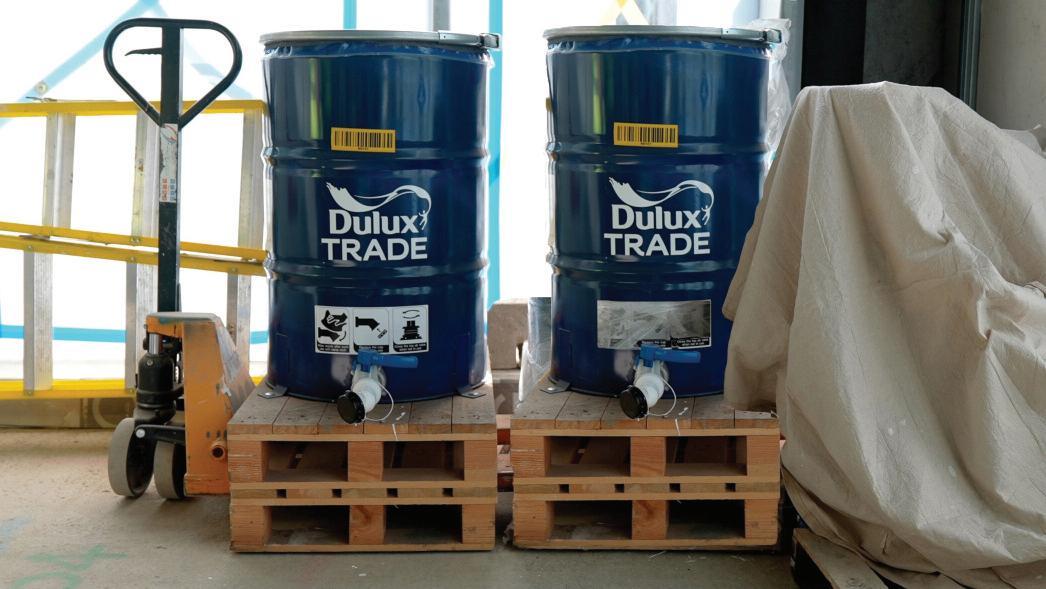
recommended The range is also resistant to water-based stains such as red wine and coffee, as well as oilbased stains such as food or cosmetics providing further durability

products are applied, they will help to extend maintenance cycles thus reducing material use and waste with the added benefit of reducing costs as well Paints that protect walls against scuff marks, such as Dulux Trade Scuffshield are ideal for It’s also important that marks can easily be removed to maintain the professional finish for longer This can help to ensure that tenants feel proud of their living spaces as they are able to keep their space looking new Products like Dulux Trade Diamond Matt have been tested to withstand scrubbing and are therefore,
Reducing packaging waste
For larger projects that require a high quantity of paint, the use of conventional 10L paint cans can result in a significant amount of waste especially if the cans are not recycled It is therefore important to select a paint supplier like AkzoNobel that offers larger, reusable 170L paint containers These are ideal for bigger schemes, as they can be refilled throughout the duration of the project to ensure a consistent supply of paint on site all while improving sustainability and reducing waste
An increasing number of decorative merchants also offer free Can Recycling Services, helping to ensure empty packaging is recycled Painting contractors can often simply hand empty packs over when collecting new materials
Overall, it is imperative that social housing providers work with painting contractors to ensure that the paints and coatings used in their projects stand the test of time and reduce impact on the environment Small and easy steps such as using durable, lower-VOC water-based paints, opting for larger paint containers or simply ensuring higher rates of recycling can all together to make a real difference
1 Department for Energy Security and Net Zero ‘2022 UK greenhouse gas emissions, provisional figures’, 30 March 2023, p 13 This includes emissions from heating homes and cooking but does not include emissions from the generation of electricity consumed by households
n For further information and guidance about sustainability, visit www rdr link/lar011

 AkzoNobel offers larger, reusable 170L paint containers
AkzoNobel offers larger, reusable 170L paint containers

OS B in tim ber f ram e c onstr u cti on
Rebecca Goldsmith, Product Manager at MEDITE SMARTPLY explains why innovative OSB panels that integrate air and vapour control layers are a potential game-changer in timber frame construction, offering a robust sheathing solution for local authorities and contractors striving to meet the stringent airtightness requirements required by the Future Homes Standard.
The challenge for social housing providers and housebuilders to meet the UK Government’s mandatory Future Homes Standard in 2025 will mean they will be required to build new homes that produce 75-80% less carbon emissions 1 Local authority housing will need to be
low carbon and energy-efficient with an emphasis on enhanced levels of airtightness Structural timber offers a sustainable solution, thanks to its inherent sustainability, versatility and rapid build times making it an attractive option for both traditional and modern methods of construction
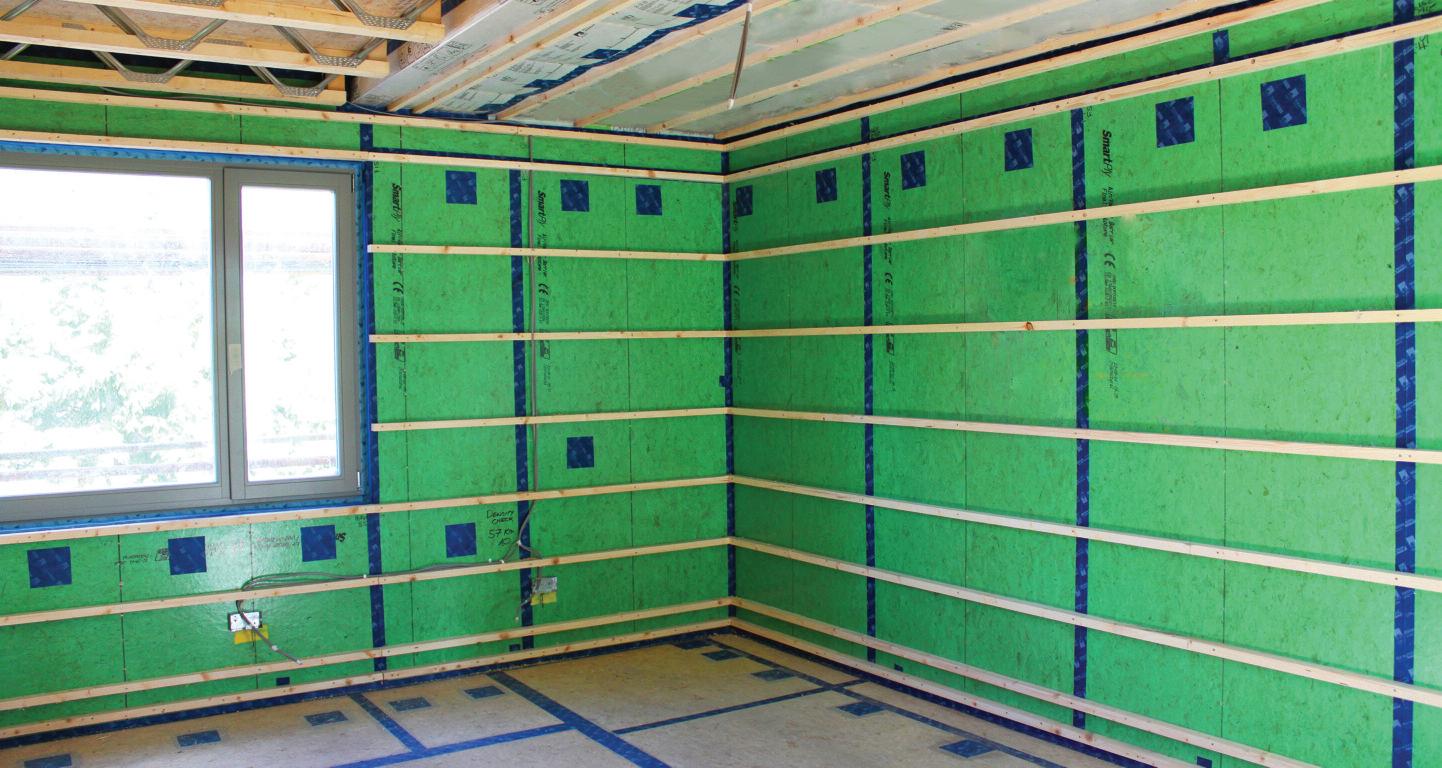
The pressure on local authorities faced with decarbonisation targets and shortages of new housing is unprecedented It’s why key stakeholders need to be aware of the important role that structural timber systems can play in our journey to net zero Maximising the use of timber in new social housing schemes in place of other materials is an effective route to reducing the carbon impact of new homes
Furthermore, structural timber systems offer a simple route to achieving the required levels of airtightness and thermal performance whilst at the same time offering social housing providers the speed and reliability of construction
A key area will be addressing the thermal performance and the design of a building’s envelope This heightened focus on the building fabric presents both challenges and opportunities As a route to more thermally-efficient building envelopes, it will become critical to ensure buildings are airtight Timber frame
HOUSING & REGENERATION
The Stirling Prize winning housing scheme Goldsmith Street in Norwich
The Goldsmith Street housing scheme features SMARTPLY AIRTIGHT panels as part of the timber frame system
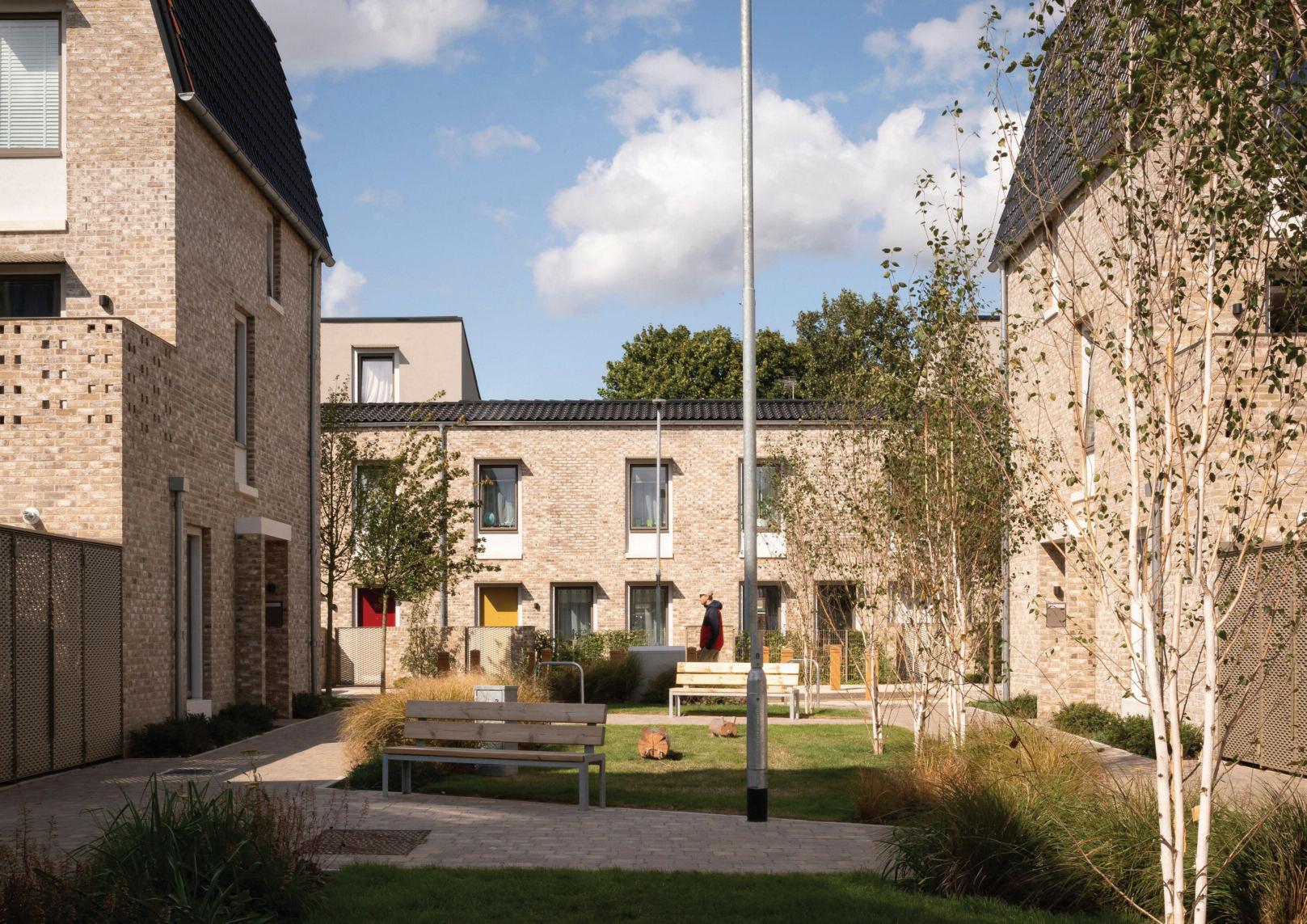
manufacturers that can provide highperformance, airtight envelope solutions will be well-positioned to meet these changing regulations and capitalise on the move towards low-energy construction
Thermal envelope solution
To meet the evolving energy efficiency standards, there is an innovative solution to simplify the path to airtight building envelopes The increasing demand for double sheathed timber frames in both structural applications and the development of offsite closed panels, led to innovation for producing two certified airtight OSB/3 panels with airtightness engineered into the panel substrate
As a solution for walls and ceilings, SMARTPLY AIRTIGHT panels can be used as the airtight layer on the warm side of the insulation in timber frame construction systems, helping to create an airtight building envelope Each panel features alternating layers of wood strands coated with a high quality formaldehyde-free resin and wax binder system to deliver outstanding levels of airtightness A specialist coating is then applied to ensure vapour resistance and provide a quality assured OSB solution for superinsulated and passive buildings, and enable the elimination of a traditional additional vapour control membrane from the construction
By integrating air and vapour barriers into highly-engineered OSB panels, this streamlines the installation process, minimising the risk of air leakage that often plagues traditional timber frame structures
For flooring and roofing, SMARTPLY SURE STEP is a tongue and groove, load
bearing OSB/3 panel that provides improved durability and slip resistance in all site conditions It can also be used as an airtight layer, contributing to sustainable building practices as well as reducing the energy consumption for heating
These solutions not only simplify construction but also ensure a certified, proven approach to creating airtight building envelopes that will pave the way for low carbon, energy-efficient homes of the future
Future-proofing social housing
Stirling Prize winning housing scheme Goldsmith Street in Norwich is testament to the exceptional performance standards achievable through offsite timber frame construction This social housing scheme, comprising 105 ultra-low energy homes for Norwich City Council, is an excellent example of how innovative building materials and techniques can deliver Passivhaus standard quality homes, even on a tight budget and limited urban site
At the heart of Goldsmith Street's energy-efficient design is the use of SMARTPLY AIRTIGHT panels as part of the timber frame system, supplied by timber frame manufacturer Cygnum The highperformance OSB panels seamlessly integrate the critical air and vapour control layers, streamlining the construction process and ensuring a consistently airtight building envelope
The buildings are timber-framed; using panels manufactured offsite by Cygnum Walls incorporate recycled cellulose insulation within the panels and rigid insulation boards on the outsides
The Cygnum Passive system featured a twin-wall design, with a membrane on the
inside forming the airtight layer The buildup featured an 89mm stud, and a second 67mm stud, fully cellulose-insulated with an overall wall thickness of 399mm, ensuring exceptional thermal performance and eliminating thermal bridging
Utilised in the floors, roofs and internal face of the external walls, SMARTPLY AIRTIGHT OSB/3 provided the ideal solution in the creation of these highly insulated timber frame structures, helping Cygnum achieve a very consistent and excellent result for thermal performance By factory-assembling the intermediate floors and roof cassettes with the same cellulose-insulated approach, the Goldsmith Street development exemplified the quality, speed, and precision of offsite timber frame construction
Integrated air barrier
As local authorities and social housing providers brace for the transformative impact of the Future Homes Standard, timber frame construction offers many advantages in meeting the stringent airtightness levels and energy efficiency requirements By utilising OSB that features integrated air barrier properties, timber frame manufacturers can deliver airtight, energy-efficient building envelopes needed to comply with the new regulations
1 https://www gov uk/government/consultations/ thefuture-homes-and-buildings-standards-2023consultation/the-future-homes-and-buildingsstandards-2023-consultation#updated-guidanceand-minimum-standards

M A Y / J U N E 2 0 2 4 L A B M I 2 1 “B y fa c t o r y - a s s e m b l i n g t h e i n t e r m e d i a t e fl o o r s a n d ro o f c a s s e t t e s w i t h t h e s a m e c e l l u l o s e - i n s u l a t e d a p p ro a c h , t h e G o l d s m i t h S t r e e t d eve l o p m e n t e x e m p l i fi e d t h e q u a l i t y, s p e e d , a n d p r e c i s i o n o f o ff s i t e t i m b e r f ra m e c o n s t r u c t i o n . ”
n To find out more about the SMARTPLY OSB range visit www rdr link/lar012
The Goldsmith Street housing scheme comprises 105 ultra-low energy homes
Wates introduces ‘Healthy Homes’ service Wates, which manages repairs and maintenance for over 500,000 homes on behalf of 65 social landlord customers, has launched a new dedicated service designed to combat two of the greatest challenges facing social housing, disrepair, and damp and mould the new Healthy Homes service will see Wates offer existing and new customers a bespoke programme of work, utilising both a direct labour force and specialist supply chain to help social landlords provide healthy homes for their residents

Formed of two individual workstreams, with compliant routes to markets through a range of frameworks, Healthy Homes will focus on the company ’ s efforts to reduce the number of nationwide disrepair cases, helping social landlords to address repairs before they become legal disputes, reducing legal fees and resulting in happy and safe residents alongside disrepair, Wates’ Healthy Homes service also includes work to address the increasing challenge of damp and mould
n To learn more about the services available, visit www.rdr.link/lar013

New external wall insulation guide inCa has published best practice guidance on the installation of external wall insulation designed to ensure that eWi systems are fit for purpose and installed to the very highest of standards the first of three guidance documents scheduled for publication in 2024, the best practice guide focuses specifically on eWi systems incorporating a render finish and defines the installation process, standardises common details, and provides useful information on the materials and components that make up a finished system designed to support all sectors of the industry (new-build, refurbishment, domestic and non-residential), the new inCa best practice guide defines the recognised standards required to achieve optimal thermal performance and to ensure the highest quality of installation and aesthetically pleasing results it is also intended to help and inform specifiers, main contractors, and clients in the correct choice of system for their projects
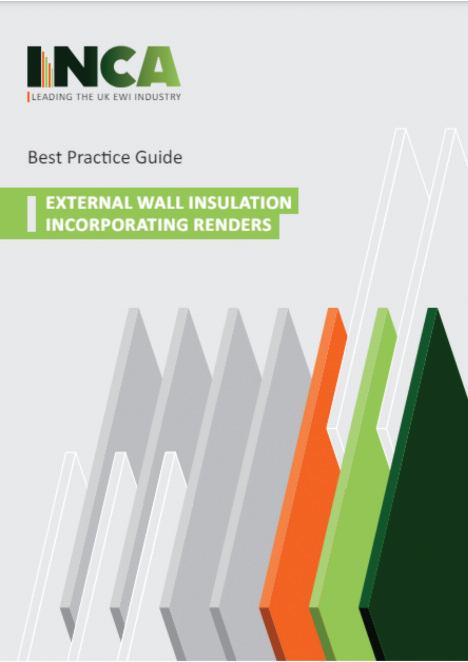
n Download a copy of the guide here www.rdr.link/lar014
rdr.link
Introducing rdr.link
A new digital service for our readers
With a wide array of online resources supporting the latest solutions – from videos to technical guides, PDFs to Podcasts – it can be a challenge to locate what you need.
To ensure you don’t miss out on these valuable resources, we are introducing rdr.link – a new, rapid service to transport you immediately to the online resources mentioned in our stories.
So, in articles you may now see things like: “To view an exclusive time-lapse video of the process use rdr.link/AA101”
Simply enter rdr.link/ with the unique 5 digit code into a browser and it will take you directly to the mentioned resource – in this case the video.
Designed to help busy professionals rapidly locate more information – look out for & use rdr.link
RegeneRation Round-up
Housing &

Regional Retrofit Skills Taskforce Checklist
As the drive towards achieving net zero emissions intensifies, the National Retrofit Hub (NRH) has released its latest tool to support regional efforts: the Regional Retrofit Skills Taskforce Checklist It serves as a comprehensive guide to help regional authorities develop robust skills plans, facilitating stronger connections between retrofit delivery and economic development programmes It acknowledges the crucial role of convening housing providers, training providers, and retrofit employers both large and small in adopting a 'system-wide' approach By ensuring that businesses and training providers understand the local pipeline of retrofit work, the checklist aims to facilitate the seamless transition of learners into job roles The checklist considers how procurement can be leveraged to increase training and job opportunities, engagement tactics for local SME construction and building services firms
n The checklist can be downloaded here www.rdr.link/lar015

Guide to renders and decorative finishes for MMC
A free guide on how to incorporate traditional decorative finishes into modern methods of construction (MMC) is now available from Saint-Gobain Weber The new ‘Guide to Renders and Decorative Finishes for MMC’ explains how pre-manufactured value (PMV) is attained and gives an overview of the most common types of MMC and materials, as well as the different finishes that can be used with these methods of construction One area where it’s easy to specify a PMV-improving element is using modern alternatives to traditional brickwork, and weberwall brick, which provides a realistic and timeless brick-effect finish without using actual bricks, meets this criteria The fast fix alternative to brick slips can be used for both refurbishment and new-build projects, as well as internally
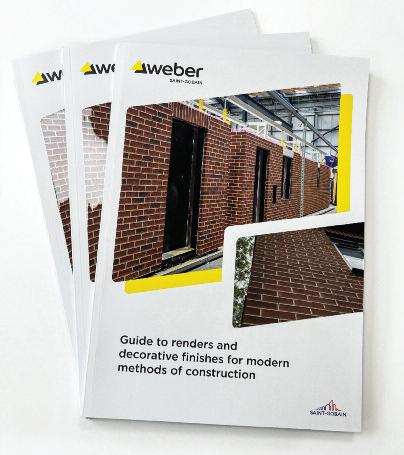
n A copy of the guide is available here www.rdr.link/lar0016
Energy-efficient underfloor heating
Henco is showcasing its extensive range of underfloor heating systems on stand 5C84 at Installer 2024 at the NEC in Birmingham from 25-27th June Its underfloor and wall heating systems are engineered to provide even heat distribution and designed so that every cm2 can be utilised for optimum efficiency By using advanced pipe networks embedded in floors or walls, the range ensures a comfortable and cosy environment, free from cold spots or drafts The system is made of high quality and robust ALU ML pipes, is lightweight and is detectable when installed The sustainable pipes provide the ideal partner to combine with energy-efficient heating such as heat pumps and solar panels
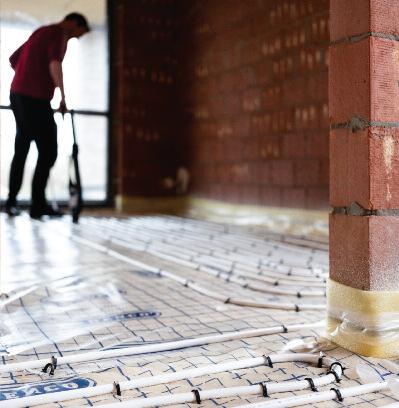
n More details on Henco’s product range here www.rdr.link/lar017



Building fire-rated breather membranes into safety strategies

It’s never been more important to be able to validate the safety and performance of building materials and when specifying ‘hidden protectors’ such as construction membranes, trust and transparency within the supply chain is vital. Here, Head of Technical James Smith from Glidevale
Protect takes a closer look at what specifiers should consider when choosing fire-rated breather membranes for their next project
Wall breather membranes are an important part of the design of building façades Not only do they provide a temporary line of protection to the whole of the external wall to prevent water penetrating and damaging the exterior of the building during the construction process, but breather membranes can also significantly reduce the risk of interstitial condensation within the structure, allowing water vapour to escape into the vented cavity Over the life of the building, breather membranes provide a second line of protection against rainwater penetration after the external façade is built

It’s also advisable to evaluate the products available in terms of their tensile strength, which illustrates how strong and flexible the membrane is, and their UV stability which relates to how long the product can be exposed during the construction process before being covered The latter is a particularly important consideration for high-rise schemes where the façade materials may be exposed to the elements for longer as construction work progresses Hand in hand with these high-rise schemes or any development over 11m is the subsequent development of flame-
retardant external wall breather membranes that offer fire-resistant solutions These products provide additional peace of mind and more importantly for local authorities and specifiers working in the public sector, can help future-proof buildings in terms of both their safety and compliance with the evolving regulations
Role of breather membranes in fire protection
A breather membrane that offers not only waterproofing but additional fire-resistant properties can contribute positively to the overall fire safety performance of a build
Installed on the external side of the frame to integrate with façade wall structures, they are particularly suited for use in higher risk buildings, such as high-rise residential accommodation They are also an ideal solution for retrofit projects such as older social housing blocks which, as well as being more likely to suffer from damp and condensation, could also have a fire risk
The current Building Regulations
Approved Document Part B for fire safety
T h e r e a r e m a n y d i f f e r e n t t y p e s o f b r e a t h e r m e m b r a n e s a v a i l a b l e, i n c l u d i n g r e f l e c t i v e, i n s u l a t i n g m e m b r a n e s t h a t c a n h e l p a c h i e v e l o w U - v a l u e s t o m e e t n e w s t r i c t e r t a r g e t s o f B u i l d i n g Re g u l a t i o n s A p p r o v e d D o c u m e n t Pa r t L f o r u s e w i t h d i f f e r e n t b u i l d i n g c o n s t r u c t i o n t y p e s s u c h a s t i m b e r f r a m e, St r u c t u r a l I n s u l a t e d Pa n e l s ( S I P s ) , C r o s s La m i n a t e d T i m b e r ( C LT ) p a n e l s a n d l i g h t g a u g e s t e e l f r a m e c o n s t r u c t i o n
M A Y / J U N E 2 0 2 4 L A B M I 2 5 FIRE PROTECTION
SECURITY
&
High-rise residential building of flats with cladding being replaced with fire resistant materials Image ©Richard Johnson/AdobeStock

“...it is impor tant to consider the long-ter m fire resistant perfor mance of any specified systems , ensur ing the products used are future-proofed against regulation change.”
states that external wall membranes must achieve at least a Class B fire rating for structures over 11m With an update to these regulations likely to ensure the continued future safety of constructed buildings, it is important to consider the long-term fire resistant performance of any specified systems, ensuring the products used are future-proofed against regulation change
The increased availability of Class A firerated membranes such as Glidevale Protect’s new FrameSafe FR A2 product does make this process easier but as always, it’s important to demand full transparency from manufacturers on how these products have been tested and their performance results The devil is in the detail and full disclosure is essential
Understanding fire testing
Trust is everything and any reputable manufacturer should be able to provide a full breakdown of how their products have been tested This information should be presented in a clear and accessible way but if in doubt, there are key questions to ask Has the product been independently fire tested in a laboratory by a third-party? Has the membrane been tested both free hanging and as part of a system in an end-use application? Has it been assessed on different substrates? What about the fixings?
As specialist fire-rated tape is required to seal laps, it’s also important to be clear if these products have also been independently fire tested as part of the overall system Although fire testing of the tape itself is over and above the requirements of Building Regulations, Glidevale Protect has included the tape used with its FrameSafe FR membrane as part of its fire testing


Understanding the reaction to fire classifications is also important and it should be made explicit if an FR membrane is rated as a Class A1, A2 or B product and what this result is both free hanging and as part of a system with the membrane fixed to a substrate To illustrate, the Protect FrameSafe FR membrane achieves Class A2-s1, d0 both free hanging and when mechanically fixed to both A1 & A2 substrates in an end use application, offering protection against the propagation of fire Class A2 materials like this have very limited combustibility and contribution to fire and products achieving Class A ratings should have been subjected to the most stringent tests covered by BS EN 13501-1 –Fire classification of construction products and building elements
As specified in BS EN 13501-1, for a lightweight product like a membrane, two different fire test methods are required to achieve a Class A reaction to fire classification These are tests to ISO 1716 which assesses the amount of energy released when a material is completely combusted during a bomb calorimeter test and BS EN 13823 which assesses smoke production, flame spread and energy release The BS EN 13823 single burning item test method simulates a fire starting in the corner of a room with material under test exposed to the development stage of a fire
Which types of projects can benefit?
Fire-rated external wall breather membranes are an important consideration from all public use buildings but particularly those
that have been defined as ’ higher risk’ in the 2022 Building Safety Act, such as high-rise housing, student accommodation schemes, schools, hospitals and care homes They also provide a practical solution for use on schemes in London where for many developments there is a combustible material ban on external wall structures of buildings For housing developments where the property has a minimum separation distance of 1m to the relevant boundary, this also necessitates the need for a fire rated external wall membrane to be specified
A breathable solution for fire safety
With fire safety in the frame and a critical aspect during and after construction, flame retardant breather membranes can play an important role in supporting and protecting the integrity of the building façades and the safety of building users by reducing the risk of fire spread and smoke transfer
A robust fire safety strategy should be integrated from the initial designs stages of a project and provide a ‘golden thread’ of information throughout the construction and post-occupancy stages Partnering with a manufacturer that can provide full transparency of how the product has been developed and tested, and technical support throughout the installation process is an important step on the journey to designing, constructing and maintaining safer buildings for all

2 6 I L A B M M A Y / J U N E 2 0 2 4
n More information can be found at www.rdr.link/lar018
SECURITY Protect FrameSafe FR annotated wall build up
FIRE PROTECTION &



Vital role of building control
Assent talks to LABM about enhancing fire safety on building projects and the essential role of Registered Building Control Inspectors.
Fire safety is a multi-faceted profession that requires a thorough understanding of building design, materials and legislation The role that Registered Building Control Inspectors (RBIs) play in ensuring buildings’ resilience against fire emergencies cannot be overstated From technical aspects of their work and its challenges to the everchanging legislation that must be satisfied, building control requires the highest level of training and compliance
The regulatory landscape
The Building Safety Act (BSA) and Building Safety Regulator (BSR) have been the biggest changes in legislation the sector has seen for a generation, including a more in-depth approach and control related to fire safety management and information, particularly to residential buildings
Under new legislation (apart from HRBs), a developer would either apply to the local authority or appoint a Registered Building
Control Approver (RBCA) Once the Initial Notice is served, the key function of the RBCA is to ensure, within the limits of their professional skill and care, that the functional requirements of the Building Regulations are achieved This involves processing prescribed forms for the works, assessing submitted design information and carrying out the inspection of work for the purpose of checking compliance
These are ‘restricted functions and activities’ which can only be undertaken by RBIs working directly for the RBCA
Separately, if a housing association starts a project of any building over 18 metres or seven storeys high, otherwise known as a Higher-Risk Building (HRB), this would be handled directly by the BSR
Technical responsibilities of RBIs: Approved Document B
Once an RBCA is appointed by a housing association, all works should satisfy the functional requirements of Part B of the

Building Regulations 2010 This is achieved by following the guidance of Approved Document B – Fire Safety, or in the case of residential buildings, British Standard 9991 or demonstrating compliance through a fire engineered approach Approved Document B provides key guidance for how a building must meet the current Building Regulations Specifically, these concern fire safety, including the control of fire spread of both linings and structure, means of warning and escape, and access and facilities for the fire service
M A Y / J U N E 2 0 2 4 L A B M I 2 9 FIRE PROTECTION & SECURITY
p ro p o s e d , s o a rc h i t e c t s a n d
b
s m o ke p ro d u c t i o n , fl a m e
s p r e a d a n d s t r u c t u ra l
i n t e g r i t y. ”
Fire load assessment
RBIs evaluate key aspects of the proposed fire load within the building, determining the potential severity in the event of fire This involves assessing the proposed use and specification of construction materials, linings, finishes and services within the building against applicable functional requirements, satisfying the Building Regulations
Compartmentation analysis
Limiting its spread is a key component of modern building fire safety, which can be done with fire-resistant construction and satisfying specific compartmentation requirements to slow the spread and help prevent smoke and toxic gases from infiltrating other areas RBIs will evaluate key aspects proposed to control fire spread such as protection measures to ceilings, floors and wall linings and ensure they satisfy required fire resistance ratings They will also verify that any fire doors and seals are correctly specified and installed
Escape route design
In case of emergency, efficient evacuation measures must be in place and maintained, with the layout of escape routes vital in facilitating safe means of escape During plan assessment and inspections, the RBI will assess the width, travel distance and overall accessibility of escape routes, whilst considering important factors like stairwell capacities and applicable active fire safety and smoke control measures


Fire-resistant materials
These can include anything from fireretardant coatings to appropriate firerated glazing The role of an RBI is not to provide design advice but to assess design information proposed, so architects and builders can specify and install the correct materials that maximise fire safety, considering factors such as smoke production, flame spread and structural integrity
Fire suppression systems
RBIs will evaluate where fire suppression systems are required and assess proposed design and installation
Depending on building size, the scope of fire suppression needed can vary: for example, any residential building over 11 metres in height requires sprinklers RBIs will also ensure the correct installation, testing and commissioning before the building is occupied
Smoke control
We all know smoke can be as, or even more, deadly as flames All smoke control systems, where required, require assessment and testing, ensuring maintenance of an effective means of escape strategy
Challenges and compliance
A key consideration is the ever-changing landscape of public sector construction, brought about by the BSR and BSA With continuous fire safety updates and legislation being introduced, it is vital that those
involved are up-to-date with current regulations to ensure that they comply with new requirements, including appropriate use of non-combustible cladding specifications, overall life safety evacuation procedures and correct use and maintenance of fire doors
Ensuring compliance and regulations are met whilst dealing with practical implementation requires an effective balance For example, applying fire safety principles without compromising unique architectural features requires innovative solutions from a suitably competent design team, particularly in retrofit or heritage projects
Staying within the line of the Building Conservation Officer’s requirements, whilst abiding by the building and fire safety regulations of today, can become complex, varying from project to project A delicate balance is needed to not only preserve the building’s original integrity, but also showcase forward-looking approaches in maximising life safety and compliance of the structure
It is important to always remember the pivotal role of RBIs in fire safety With the evolving regulatory landscape, an RBI’s technical expertise is needed to help ensure compliance, and complete comprehensive evaluations for the safeguarding of buildings and its occupants against fire emergencies

3 0 I L A B M M A Y / J U N E 2 0 2 4 “T h e ro l e o f a n R B I i s n o t t o
s i g n a d v i c e b u t
p rov i d e d e
t o a s s e s s d e s i g n i n fo r ma t i o n
u i l d e r s c a n s p e c i f y a n d
e c o r r e c t ma t e r i a l s
x i m i
fi
e s a fe t y,
i n s t a l l t h
t h a t ma
s e
r
c o n s i d e r i n g fa c t o r s s u c h a s
n For more information on Assent and its services visit www.rdr.link/lar019 FIRE PROTECTION & SECURITY All smoke control systems,
mandated, require assessment
testing
where
and



How frameworks support with fire safety
Paul Dawson, Group Technical Manager at LHC Procurement Group (LHC) discusses how frameworks support local authorities and housing associations to deliver fire safety projects and comply with building safety legislation.
The construction industry is currently undergoing the biggest changes to building and fire safety witnessed for a generation, as it adapts to the Building Safety Act 2022 (BSA), Fire Safety Act 2021, and Fire Safety
(England) regulations 2022 The former establishes a more effective regulatory and responsibility framework and introduces clearer standards and guidance, putting residents at the heart of a new system of building safety
With the establishment of the Building Safety Regulator (BSR), the BSA places legal responsibilities on the whole supply chain to contribute to, maintain and manage building safety information


Clients are required to make suitable arrangements for planning, managing and monitoring their project so that it complies with all relevant requirements That also includes the management of a digital ‘Golden Thread’ of information from build through to maintenance, for higher risk buildings This makes data capture all the more critical
Mounting pressure

N o t o n l y d o l o c a l a u t h o r i t i e s h a v e t o l e g a l l y c o m p l y w i t h t h e a b o v e, b u t t h e y a l s o f a c e o n g o i n g p r e s s u r e t o d e c a r b o n i s e t h e i r s t o c k i n t h e r a c e t o n e t z e r o a n d g r a p p l i n g w i t h o n g o i n g r e p a i r, m a i n t e n a n c e a n d i m p r o v e m e n t M A Y / J U N E 2 0 2 4 L A B M I 3 3 FIRE PROTECTION & SECURITY
Clients are looking for trusted technical expertise
Council budgets are being squeezed more than ever In the past six years a total of eight local authorities have filed for bankruptcy (Section 114), whereas none had done so in the previous 18 years One in five local authorities have expressed concerns about facing similar circumstances by 2030
While managing their day-to-day responsibilities, teams up and down the country need support to know they are compliant That’s where frameworks come in
How using a framework can help National frameworks offer a fast and efficient procurement route to market, where certain terms and rates have been pre-agreed and contractors have been pre-qualified They bring together local authorities and tradespeople to facilitate the fastest and most efficient way of ensuring buildings are made and remediated to adhere with the new regulations
Clients are looking for trusted technical expertise That’s why when designing frameworks; providers such as LHC dedicate time to engaging with the supply


chain early and embedding their knowledge and insight into each framework This close working ensures that frameworks are tailored to clients’ needs now and, as far as possible, for the four-year period the framework usually covers This includes legislative requirements and relevant examples of best practice
Before companies can be appointed to a framework, their QA processes, assurances, and data capture techniques are scrutinised They are audited and assessed for their qualifications and competencies to ensure they have the correct credentials and resources to carry out the services outlined in the workstreams they have applied for This is all done to reassure and support local authorities and housing associations in their legal obligations The idea is for them to have peace of mind, with the assurance that industry developments and best practice are followed
Free-to-use frameworks
One thing to look out for is how frameworks bring supply chain experts together to service particular issues For example, LHC has just launched a Fire Safety (FS2) framework, which will be live until February 2028
sector client feedback and the marketplace, giving access to suitably qualified and experienced contractors and consultants via a single source
Meanwhile, our ASC1 framework offers a full suite of asset safety and compliance support to help public sector organisations meet government guidelines and legal responsibilities relating to building life safety and maintenance It was launched in October 2023, just a few months after the Social Housing (Regulation) Act 2023 became law
As with all LHC frameworks, FS2 and ASC1 are designed for public sector use including areas such as blue light services, NHS trusts, and universities, and so on
Transforming public procurement
Change isn’t just happening in building safety but also in public sector procurement, with the introduction of the Procurement Act Set to come into force in the autumn, it will bring a step change in how public goods and services are bought and commissioned
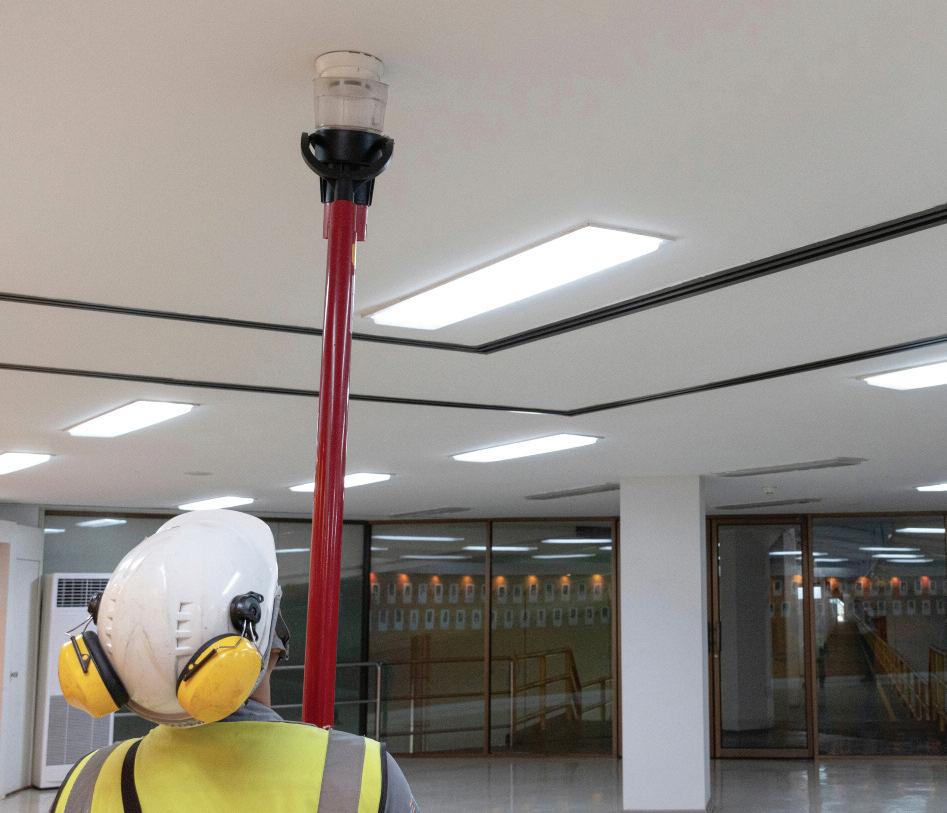

Designed collaboratively with industry experts, FS2 covers a comprehensive range of fire safety measures, including passive fire protection and containment, cladding and remediation services, fire detection and alarm systems, fire suppression systems, and consultancy services on fire risk assessments
The suite of measures has been placed under one framework to reflect public
There’s no doubt that the current regulatory landscape is a complex one for local authorities and housing associations alike, but the prospect of having to adjust to new regulations needn’t be a daunting one If you work with a framework provider, the hard work is taken care of The right one can support you with your developments from beginning to end, providing consultancy services throughout You are not expected to go it alone

p r o g r a m m e s a l l w h i l e t r y i n g t o s t a y a f l
f i
o a t
n a n c i a l l y
3 4 I L A B M M A Y / J U N E 2 0 2 4
“B e fo r e c o m p a n i e s c a n b e a p p o i n t e d t o a f ra m ewo r k , t h e i r Q A p ro c e s s e s , a s s u ra n c e s , a n d d a t a c a p t u r e t e c h n i q u e s a r e s c r u t i n i s e d . ” n
LHC’s
n
LHC recently launched its Fire Safety (FS2) framework
Find out more about
Fire Safety (FS2) framework here www rdr link/lar020
Find out more about LHC’s ASC1 framework here www.rdr.link/lar021
FIRE PROTECTION & SECURITY
LHC’s ASC1 framework offers a full suite of asset safety and compliance support
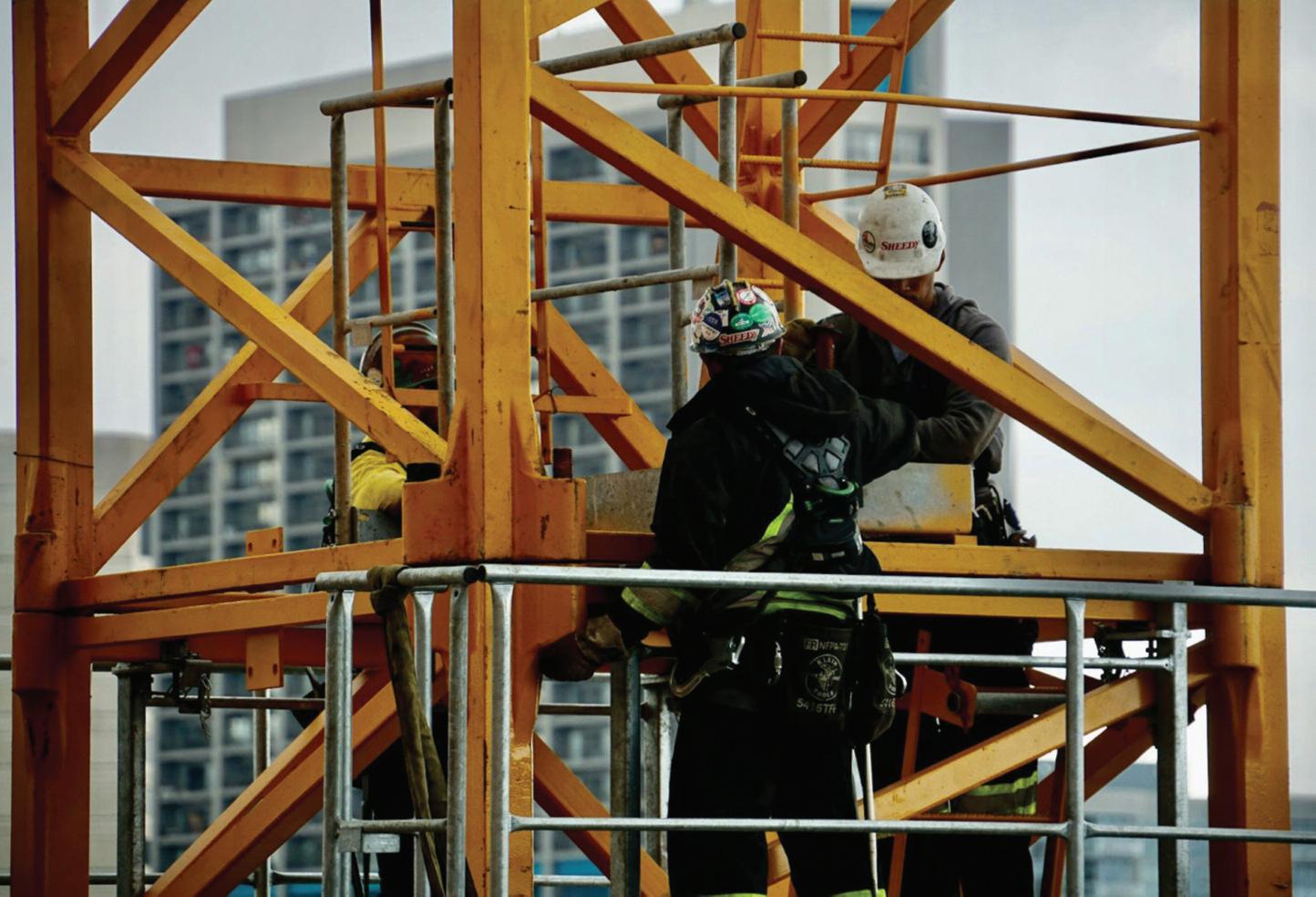
Over two-thirds (70%) of maintenance professionals state that staying compliant is the most significant problem in their organisation, according to a recent poll by SFG20.
Compliance issues for building maintenance professionals
Just over half of those surveyed report that meeting safety standards is their biggest priority in 2024
However, all poll respondents (100% of those surveyed) remain unsure about how prepared they are to comply with the Building Safety Act and the golden thread requirements for facility managers
Consistently remaining compliant can often be overlooked when maintenance budgets and strategies face rising costs of materials and labour As the focus on compliance, highlighted in the Building Safety Act, grows, facility managers are required to keep on top of their legal responsibilities whilst also pinpointing potential hazards, including: electrical, structural, and fire safety, to prevent dangerous incidents and to protect people and valuable assets
Paul Bullard, Product Director at SFG20, says: “Understanding your statutory responsibilities as a facility manager and the consequences of noncompliance is imperative Not only does non-compliance increase the risk of legal consequences and sanctions, but also it will likely lead to avoidable added costs,
such as increased insurance premiums, and a damaged reputation
“Building maintenance is no longer a backseat issue for organisations, but the cornerstone of health and safety, and efficient running costs A ‘fix on fail’ approach might work for non-statutory maintenance, but the approach can mean statutory tasks are not completed, creating significant risk to both building owners and occupants
“Codes of practice and industry standards are often generic, requiring expertise to add the important final layer of how this can be achieved The SFG20 technical authoring team reviews legislation and regulations, then researches
supporting documentation to create a list of actionable tasks for those responsible for maintenance and completed efficiently and on-site by maintenance personnel With the Building Safety Regulator committed to enforcing compliance in the FM space, they will be using industry standards as their benchmark ”
SFG20 held a webinar recently, ‘Building Maintenance Compliance: Do you understand your responsibility?’,
where experts gave insights on the responsibilities of a building owner, facilities manager or contractor on how to achieve statutory compliance, and the consequences of non-compliance, which is available to watch on catch-up
About SFG20
Launched in 1990 by the Building Engineering Services Association (BESA), SFG20 is recognised as the industry standard for building maintenance specification With access to an extensive library of maintenance schedules that update dynamically to reflect changes in legislation and health and safety regulations, FM professionals can create customised maintenance schedules designed to ensure compliance while also saving time, effort and money
n For more information about staying compliant and keeping up with changing legislation to ensure effective completion of statutory tasks, watch SFG20’s webinar here www.rdr.link/lar022

M A Y / J U N E 2 0 2 4 L A B M I 3 5
FIRE PROTECTION & SECURITY ROUND-UP
FIRE PROTECTION & SECURITY ROUND-UP
Video unlocks door specification potential to enable golden thread
ASSA ABLOY Opening Solutions has launched a video showcasing the possibilities BIM software offers in creating and visualising openings for complete door, frame and hardware schedules and specifications, enabling the golden thread of information

Openings Studio integrates with design software, meaning door assets can be designed, priced, manufactured, installed, inspected, and maintained from the same data, ensuring a seamless and transparent connection from design intent through to product in service
This time and cost saving application ensures compliance, giving peace of mind There’s the option to create door solutions from scratch, or select from a customised library, making it simple to create modifications to meet project specific standards Door solutions can be exported with ease through various types of reports in PDF, Microsoft Excel and Word formats During construction, submittals can be reviewed, and materials can be tracked for ordering and delivery What’s more, Requests for Information (RFIs) can be officially logged and managed, and directives can be changed Cut sheets and installation guides are also housed within the programme
Ideal for both new construction and existing openings, Openings Studio also allows facilities managers to have a single point of reference to inspect, record, maintain, and service doors, hardware, and access control systems
n To view the video, go to www.rdr.link/lar031

n To find out more about BIM, Openings Studio and how ASSA ABLOY Opening Solutions can help your organisation visit www.rdr.link/lar023
New structural compendium for higher-risk buildings
The Building Safety Act 2023 requires that some 12,500 higher-risk buildings (HRBs) are to be assessed over 2024 to 2029 to inform a safety case about how fire and structural safety risks are managed With an additional 2,000 HRBs being constructed each year, this five-year process makes for a considerable workload To help building assessors with this significant assignment, the Institution of Structural Engineers (IStructE) is releasing new guidance Assessing higher-risk buildings under the Building Safety Act: a compendium of structural typologies
The Building Safety Act defines a HRB as a development of at least seven storeys or 18 metres high, containing at least two residential units This compendium details 16 common HRB typologies The guide focuses on UK buildings constructed or adapted between 1920 and 2020, with a description, a schedule of applicable building codes at the time of construction, and possible defects and other issues to be aware of The guide therefore assists in assessing compliance with code time of construction and assessment of structural safety as required by the Act

Securistyle products achieve renewed EPD certifications
Securistyle has renewed the Environmental Product Declarations (EPDs) for several of its key products, underlining the brand’s commitment to sustainability
The Sterling Lock for windows, the Parallel Plus window hinge, the Sterling Advanced Detachable Restrictor, the Sterling window hinge and the Storm Balanced window hinge have all had their certifications extended
Globally recognised, the declarations provide environmental information on the products and the materials used to make them This includes the environmental implications of the raw materials sourced and used; the services used during their production, including electricity, gas and water; and their transportation impact and how much waste they generate As a result, specifiers can continue to enjoy complete assurance of the products’ environmental responsibility and meet regulatory requirements such as LEED and BREEAM a key consideration when fitting out new buildings
The recently launched Sterling Advanced Detachable Restrictor is NYCDoH-accredited and ensures safe ventilation in high-rise commercial buildings Designed with

Reinforced Autoclaved Aerated Concrete (RAAC) is covered in the Compendium, which is especially relevant and important given the recent prevalence of RAAC-related issues reported in schools, hospitals, and other public buildings
n The Compendium is available here www rdr link/lar024
n To find out more about the Sterling Advanced Detachable Restrictor and the entire Securistyle range, visit www rdr link/lar025

3 6 I L A B M M A Y / J U N E 2 0 2 4
Fire door replacement programme in South Lanarkshire
The CCG Group, one of Scotland’s largest privately-owned construction and manufacturing companies, successfully concluded a major fire door replacement programme in South Lanarkshire recently Undertaken on behalf of South Lanarkshire Council, the company supplied and installed over 2,253 FD60 flat entrance and common door sets in 10 high-rise residential flatted blocks, across East Kilbride and Cambuslang in just 18 months
CCG has now begun a second, multi-phased programme with over 1700 doorsets supporting a further 1000 residences in East Kilbride, Cambuslang, Hamilton and Rutherglen as part of a 12month, £5 4m workstream
FD60 doors are designed to mitigate the spread of fire, gases and smoke in a building for 60 minutes with the purpose of protecting lives and the remainder of the building or other buildings around it CCG’s doors are fabricated using engineered timber, which is naturally fire-resistant, from their bespoke manufacturing premises in Cambuslang They are then installed by their in-house planned maintenance division, Asset Management
CCG Asset Management Manager, Jim Cunningham, says: “CCG first launched as a small heating and plumbing contractor in 1974 These are services that Asset Management (AM) is still responsible for to this day, including fire door replacements, so the completion of this multi-phase programme carries a lot of
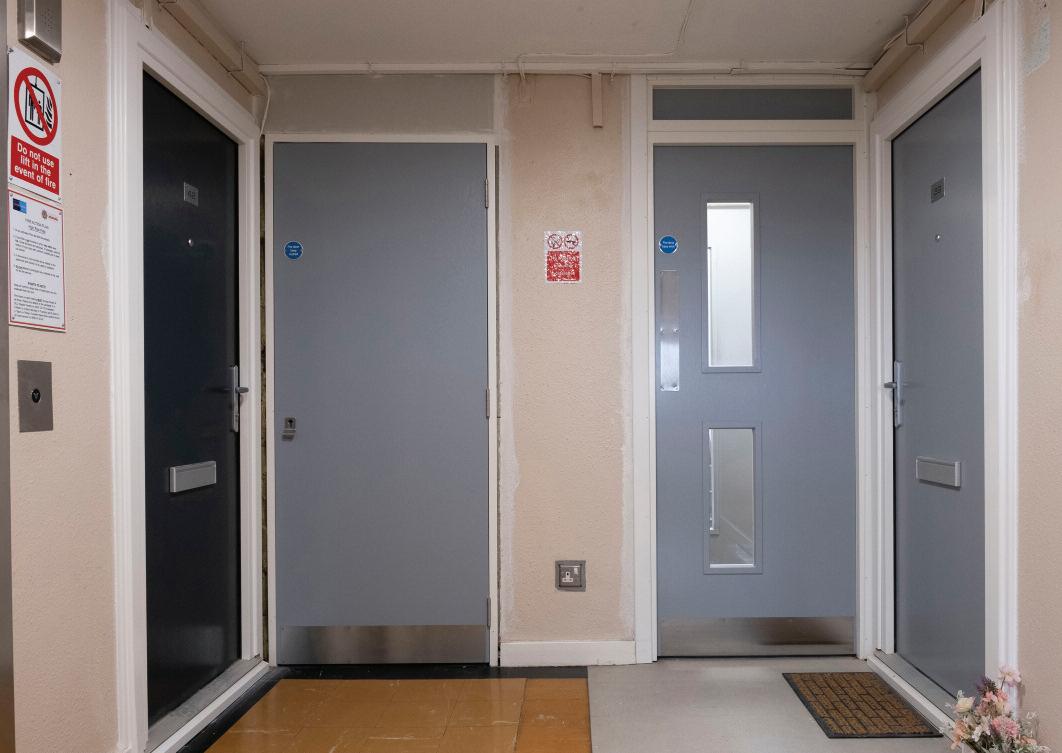
significance as it truly highlights how our division and wider business has grown and evolved 50 years on ”
n More information on the CCG Group and its services here www.rdr.link/lar026


T h e f i r e d o o r r e p l a c e m e n t p l a n n e d m a i n t e n a n c e w o r k s t r e a m w a s p r o c u r e d v i a t h e S c o t t i s h P r o c u r e m e n t A l l i a n c e ( S P A ) C 8 F r a m e w o r k



Wo r k i n g t o g e t h e r t o
d e l i v e r N e t Z e r o
Social landlord Together Housing is leading the drive for Net Zero homes in the North of England Here, Senior Manager of Net Zero Jon Schofield and Senior Project Coordinator Sheridan Boyd share how they are working in partnership to decarbonise and improve thousands of homes.
With 38,000 properties spread across mostly Lancashire and Yorkshire, Together Housing has actioned an ambitious strategy to improve the energy efficiency of its current homes and move away from fossil fuel-based heating systems
Together Housing is seeking a 50% total reduction in operational carbon impact over 10 years by 2030 and to ensure all new homes have an EPC A


rating plus generate up to 50 megawatts of renewable power using solar energy and battery storage systems
Jon Schofield, Senior Manager of Net Zero at Together Housing explains: “Together Housing devised a carbon reduction strategy in 2021 that underpins all our investment in energy efficiency across our housing stock, and we ’ re committed to raising all our properties with an EPC rating of band D or below to band C or above by 2030
“This strategy has given rise to some major investments in retrofit programmes, particularly in what we call light retrofit: loft insulation, cavity wall insulation and underfloor insulation We also do deep retrofit, undertaking external wall insulation in non-traditional properties
“Rothwell Plumbing Services (RPS) is working with us to deliver a major heat pump programme, mostly across Yorkshire, and we ’ re aiming to install
ROAD TO ZERO CARBON
Together Housing is committed to raising all its properties with an EPC rating of band D or below to band C or above by 2030
Rothwell Plumbing Services (RPS) is working with the housing association to deliver a major heat pump programme

around 500 pumps year-on-year We’re almost at the end of year two, with RPS installing heat pumps, assessing the fabric of the properties things like loft insulation or cavity insulation
“I am not aware of another social landlord retrofitting homes at our scale certainly not in the North of England, and it’s critical that procurement brings in experienced contractors that have the relevant skills and experience ”
Invaluable experience
Sheridan Boyd, Senior Project Coordinator, Together Housing continues: “My team is responsible for coordinating the eventual retrofit of all Together’s properties Our procurement process places an emphasis on working with experienced contractors, people who know and understand how to work with landlords and residents
“Their skills and experience are invaluable from undertaking the initial preentry surveys through to undertaking the installations and providing ongoing support to individual households This includes lead contractors, such as RPS, working with Together’s internal teams to make sure we understand the new technologies being installed in homes how they work and how we will manage them in the future
“But on a project of this scale, it is about learning lessons quickly and as you go and working with a contractor to improve the installations from one home to another
“Air and ground source heat pumps can feel counterintuitive to residents compared to traditional gas boilers, particularly when people first start using them, and the challenge can be changing peoples’ mindsets There’s a lot of

misinformation out there about heat pumps, so it’s important that the contractor commissioning the system talk to the customer and explain how they work in the final stages of the installation
“RPS plays an important role in the process, engaging with the customers, and setting up systems to suit the needs of the household It’s not a one-size-fits-all situation ”
Smart support
Sheriden continues: “Post-installation, we ’ ve benefited from the installer having the capability to remotely access analytics on air source heat pumps, monitoring how they are operating and how customers are using them For example, RPS is responsible for heating systems for the first 12 months postinstallation and is the first port of call for any problems via remote data and diagnostics This is a very useful part of their aftercare programme, and it gets used daily
“To illustrate, we had situations last year where heat pumps had been installed in the summer, but by the winter, the customer had forgotten some of the basics
“We’d hear: ‘It’s not working, my radiators aren’t getting hot, my heating is not working’ In this situation RPS has checked the settings remotely and made evidence-based recommendations to sort it We knew it was not a technical issue and
that the heating was probably not set at the right temperature, or they’d turned it off ”
Jon Schofield agrees: “Data is critical as it allows us to work smarter in terms of how we support customers and maintain the pumps as well as monitoring how the pumps are being used by the tenants We often see instances where tenants are repeatedly switching the system off and on, disrupting the efficiency of the system
“Remote data access also allows us to diagnose underperforming systems and decide a course of action This negates the need to initially send an engineer, which saves time and resources, and is more convenient for the customers ”
A close working relationship
Sheridan concludes: “If you set yourself the target of retrofitting 500 homes a year, you must take the time to build a consistent working relationship with your lead contractors, because it’s a big challenge, so the closer you can work (and learn) together the easier it should get
“Experienced contractors, such as RPS, will not only deliver the physical and technical elements of the work, but also take a clear, honest, and concise approach to resident communications, and inevitably, where lessons have needed to be learnt, be willing to adjust alongside my team ”
M A Y / J U N E 2 0 2 4 L A B M I 3 9
An air source heat pump being installed at one of Together Housing’s properties
“I f yo u s e t yo u r s e l f t h e t a rg e t o f r e t ro fi t t i n g 5 0 0 h o m e s a ye a r, yo u mu s t t a ke t h e t i m e t o b u i l d a c o n s i s t e n t wo r k i n g r e l a t i o n s h i p w i t h yo u r l e a d c o n t ra c t o r s , b e c a u s e i t ’ s a b i g c h a l l e n g e , s o t h e c l o s e r yo u c a n wo r k ( a n d l e a r n ) t o g e t h e r t h e e a s i e r i t s h o u l d g e t . ”
Together Housing is working with RPS to install around 500 pumps year-on-year
Heat from the chalk aquifer beneath London is being used to heat three South London housing estates by retrofitting heat pumps to save carbon emissions, explains Anastasia Mylona, Technical Director of CIBSE

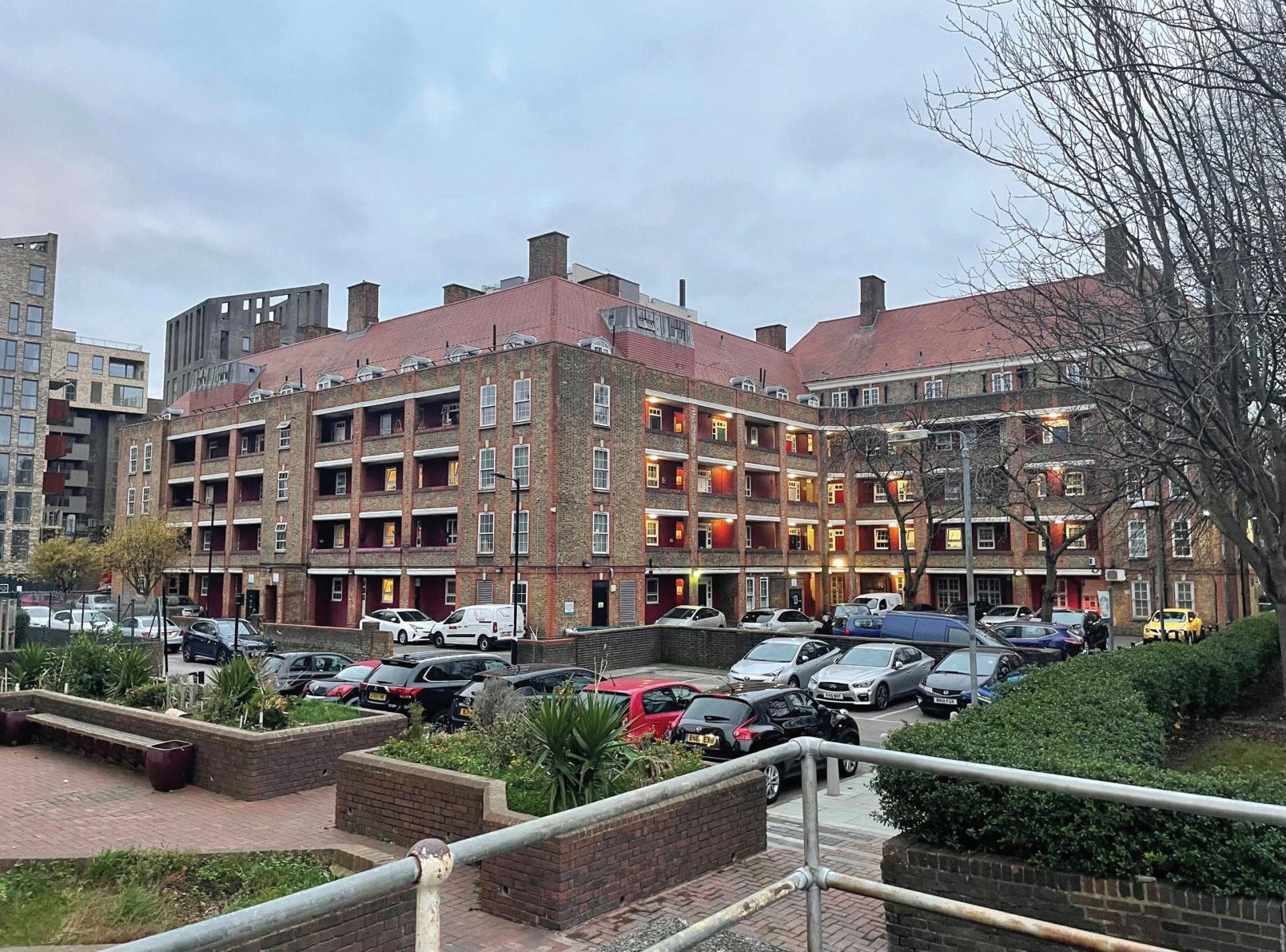
Decar bonising District Heating in Southwark
Homes on Consort, Newington and Wyndham estates in Southwark were originally supplied with heat from a local district heating network using gas-fired boilers Now, with this innovative scheme completed in September 2022, five specially developed water source heat pumps have been retrofitted to the networks to provide low carbon heat to warm over 2,000 homes
This is a project that demonstrates how heat networks can be upgraded using engineering expertise and innovative technology, which was why it was shortlisted in the Project of the Year –Residential Category in the Chartered Institution of Building Services Engineers 2024 Building Performance Awards These prestigious awards recognise proven performance in completed buildings
The scheme is predicted to help the London Borough of Southwark reduce its carbon dioxide (CO2) emissions by 1,774 tonnes per annum as part of the Borough's climate strategy and action plan By reducing the need to burn gas, it also helps reduce harmful nitric oxide and particulate emissions, improving local air quality
Of the five heat pumps, two 600kW heat pumps have been installed in the plantrooms at both Newington and Wyndham estates while a single 1,000kW unit serves the Consort estate
Keeping disruption to a minimum
To minimise disruption to the residents on all three estates, the gas-fired boilers continued to operate during the installation On all three installations, the gas boilers have been retained to add resilience and to provide top-up heat, if required, on the coldest winter days
To squeeze the heat pumps into these already congested plantrooms, internal measurements were captured using laser scanning These scans were then turned into realistic 3D images, which allowed the designers to work out how to precisely fit the new plant into existing spaces and to
connect them into the existing heat network distribution pipework
J&E Hall and ICAX worked closely with the Environment Agency to develop the scheme The system works by pumping naturally warm water up from the aquifer, 120m below ground, to the new heat pumps These extract heat from the groundwater and use it to heat the homes The cooled groundwater is returned to the aquifer
An incidental benefit of the scheme is that the temperature of the aquifer has
 Low carbon heat is being provided to homes on the Consort, Newington and Wyndham housing estates in Southwark via specially developed water source heat pumps
Low carbon heat is being provided to homes on the Consort, Newington and Wyndham housing estates in Southwark via specially developed water source heat pumps
ROAD TO ZERO CARBON
The system works by pumping naturally warm water up from the aquifer, 120m below ground, to the new heat pumps
“The scheme is predicted to help the London Borough of Southwar k reduce its carbon dioxide (CO2) emissions by 1,774 tonnes per annum as par t of the Borough's climate strategy and action plan.”
been steadily increasing because it is used as a source of cooling for buildings in the capital By removing heat from the ground water, this scheme helps reduce the rate of temperature increase
Higher temperatures
The heat pumps are unusual in that instead of providing heat at the more conventional 45˚C, they have been developed by J&E Hall in conjunction with ICAX to supply heat at 75˚C This enables the units to connect directly to the estates' existing heating systems and avoid the need to replace heating circuits and emitters in homes, which avoids disruption to residents and saves both time and cost Despite their higher than usual supply

temperature, the heat pumps are still very efficient and supply 2 9 times as much heat energy as the units consume in electrical energy Because heat pumps are powered by electricity there are no on-site emissions While it is true that some CO2 will be released by power stations, the increased use of renewables to generate electricity means that the carbon attributed to the electrical grid will continue to fall
The electricity supplied to the heat pumps will take advantage of Demand Side Management algorithms Where this can be achieved without compromising the heating requirements of the homes, the heat pumps will run when there is surplus electricity on the grid while their use will be inhibited when grid prices are high

RHI funding
Funding for the project was from a £7m low interest loan from the Mayor of London's Energy Efficiency Fund This will be repaid with income from the Government's nondomestic Renewable Heat Incentive (RHI), which has been secured by the council for 20 years Without the RHI, the project would not have worked financially because the cost of electricity is currently more than the cost of gas for heating
The funding meant residents did not have to contribute towards the capital cost of the scheme and it means there will be no increase in their cost of heating as a result of decarbonising the local district heat networks
The RHI closed to new applications on 31st March 2021, so councils looking to implement similar schemes across the country will need to find other sources of funding at least until the price of electricity drops significantly
From the London Borough of Southwark's perspective the project has been a success, despite some minor setbacks such as having to drill some of the boreholes in slightly different places to where they were originally intended of objects buried in the ground
Following the successful installation, the London Borough of Southwark has implemented a five-year maintenance package to optimise the systems' operation and maximise its efficiency in operation
n For more information on CIBSE and the 2024 Building Performance Awards, please visit www rdr link/lar027

M A Y / J U N E 2 0 2 4 L A B M I 4 1
J&E Hall and ICAX worked closely with the Environment Agency to develop the scheme

Mapping the future of timber in construction


In the UK, recognising the impact of the built environment on emissions targets, the Government instigated a new working group with a mission to increase the amount of sustainable timber used in construction in December 2021 Set up in the wake of COP26, the group ’ s work is the genesis behind the creation of the Timber in Construction (TiC) Policy Roadmap, launched in December last year The working group consists of a cross section of government departments
Andrew Carpenter says: “The Government recognised that if it’s going to meet its net zero target by 2050, and with construction responsible for 40% of all emissions, they had to consider the behaviour of the UK construction sector, and inevitably, the materials we use Concrete and steel for example are two of the biggest emitters of embodied carbon during their manufacture, whereas timber has the opposite effect, so looking at building materials was an important factor ”
Andrew Carpenter from the STA, David Hopkins from Timber Development UK (TDUK) and Andy Leitch for the Confederation of Forest Industries (UK) (Confor) represent the timber sector in the working group
Andrew Carpenter says: “Between the three of us, we cover the whole timber supply chain, and along with another dozen industry experts on the working group, including members from the RIBA, HBF and HSC, identified seven areas that we had to work on ”
Roadmap priorities
Promoting the wider use of timber as a construction material, increasing the sustainable supply of timber, growing skills, capacity and competency, improving data, particularly around whole life carbon, tackling fire safety and durability concerns, increasing collaboration and confidence with insurers, lenders and warranty providers, and promoting innovation in
timber construction systems make up the seven key areas
The market share for timber frame in housing across the UK is currently 23% The Environmental Audit Committee and Climate


M A Y / J U N E 2 0 2 4 L A B M I 4 3 ROAD TO ZERO CARBON
Image ©estivillml/AdobeStock L A B M E d i t o r C l a i re C l u t t e n s p e a k s t o A n d re w C a r p e n t e r, C h i e f E x e c u t i v e o f t h e S t r u c t u r a l T i m b e r A s s o c i a t i o n , A n d re w O r r i s s , C h i e f O p e r a t i n g O ff i c e r a t t h e S TA a n d A l e x G o o d f e l l o w, C E O o f D o n a l d s o n O ff s i t e a n d C h a i r p e r s o n o f t h e C o n f e d e r a t i o n o f T i m b e r I n d u s t r i e s , a b o u t w h y t h e i n t ro d u c t i o n o f t h e T i m b e r i n C o n s t r u c t i o n ( T i C ) P o l i c y R o a d m a p i s s o i m p o r t a n t a n d i t s i m p a c t o n t h e c o n s t r u c t i o n i n d u s t r y. Support for timber frame as a construction material is increasing in popularity in the housing sector
ROAD TO ZERO CARBON
Change Committee have suggested that as a minimum the sector should be aiming to get to 40%, almost double “Ideally they’d like to get to 80%” says Andrew
The majority of the timber currently used in structural timber applications comes from Sweden Increasing the amount of home grown timber used for structural projects is a medium to long-term objective for the sector A more immediate priority is to drive up demand and timber usage Currently, the Government has set a target to increase forestry cover in the UK by 16 5%
Growing appetite for timber
Support for timber as a construction material is growing amongst local authorities and housing associations, assisted by an increasing number of procurement frameworks which actively promote the use of timber, such as the Off-Site Homes Alliance (OSHA) national construction framework for volumetric (CAT 1) and panelised (CAT 2) Modern Methods of Construction (MMC), valued at £2bn Donaldson Timber Systems secured a place on OSHA’s framework in January this year This increasing framework activity is seen as a long-term commitment to engage with the timber sector
Alex Goodfellow says: “There is a significant amount of very progressive activity towards the use of timber within
the social and affordable housing sector
We’re seeing an increasing number of development teams within housing associations and RSLs engaging directly with businesses like ours, such as Places for People, The Guinness Partnership and Sanctuary, pulling our industry into theirs to become a partner, a supplier, an advisor, and we see that as a very positive development ”
Homes England is also actively encouraging the use of modern methods of construction on housing developments Alex says: “We offer tried and tested MMC solutions using the most sustainable of materials In April, Home England’s Chief Executive visited our new factory in Oxford The Agency is very positive about the timber panelised sector and timber sector in general for use in the affordable housing space ”
In the private sector, a number of housebuilders have already indicated a strong appetite towards timber frame construction, for example, in 2019 Barrett acquired Oregan Timber Frame Limited and in December 2023 hosted the first tour of its new £45m timber frame factory in Derby In March last year Taylor Wimpey announced plans to develop a fully automated timber frame factory in Peterborough and in May 2023, Cala acquired Taylor Lane Timber Frame

Data transparency and building safety
Discussions around embodied carbon are increasing in frequency in the built environment sector, especially with regard to how we quantify it on projects Carbon measurement is hugely important, and the working group is broadening the agenda to focus on whole life carbon and what happens to timber at the end of its life People’s level of understanding “is far greater than it was years ago, ” says Andrew Carpenter, “but there is still a lot of work to be done and we ’ re not being complacent, which is why we ’ re going to be working with the RIBA and design professionals on this
“There’s a suggestion in the Roadmap that government needs to look at carbon in the Building Regulations, which could accelerate Part Z coming in There’s also a suggestion that they should look at the ratios of usage of timber in government buildings In France for example, they’ve got a requirement that 50% of all materials in public buildings should be in timber and in the Roadmap there is a suggestion that the UK Government look at doing something similar ”
Another area of focus is Environmental Product Declarations asking the supply chain and construction companies to look at their EPDs so carbon can be measured and the appropriate data provided, instead of relying on anecdotal information
Building safety is paramount too, and continues to be an ongoing challenge for local authorities, housing associations and developers The STA has been at the forefront of fire testing during his 14 years in the role, says Andrew Carpenter, for example investing: “in an industry leading, fire in use research project to test commonly used timber frame wall, floor and roof make ups used in the UK marketplace” The outcomes of this research project are presented in the STA’s Structural timber buildings fire safety in use guidance pattern book volume 1, recently updated V 3 0, published in April 2024
One of the areas of innovation the working group is looking at is around Pre-Manufactured Value (PMV) Andrew Carpenter says: “Homes England have got a 55% requirement for PMV when it comes to funding their social housing
Frameworks like OSHA’s national construction framework for volumetric (CAT 1) and panelised (CAT 2) Modern Methods of Construction (MMC) promote the use of timber

programme, so we ’ re looking at encouraging STA members to innovate, do more in the factory, such as windows and insulation We’re also looking at cost comparisons to dispel the myth that timber frame is more expensive ”
Skills, quality and competency
The Structural Timber Association established STA Assure in 2018 to provide the construction industry with the confidence that it’s members were focused on delivering quality Andrew Orriss says: “It’s an independently audited programme that all our manufacturing members are required to comply with It’s focused on design engineering through to the erection of the structural timber on site and ensuring that all the necessary best practice has been implemented
“By using an STA Assure member, you have a reference point that they are STA Assured Gold, Silver or Bronze, which indicates the level of management systems and controls in place within that organisation So immediately you remove any doubt with regard to supplier selection, because there is a known independent body that has quality tested their work
“On the back of that, members are required to use installer/carpentry companies that have gone through the STA installer training scheme All installers are expected to meet a certain standard, and following successful completion of the installer training, they get a certificate to say ‘I’ve been through the STA training scheme’ and that links back to the STA Assure programme, where not only is the product manufactured to the highest standard, but it’s also installed with competency
“It’s also part of a continuous improvement programme that I manage, where each time, we make a step forward to raise the bar so that the industry is keeping in step with timber in construction and the expectations of quality and competency ”
On a mission
With a clear mission statement and set of priorities established in the Timber in Construction Roadmap, the working group is making good progress in its bid to deliver on the Government’s intent of increasing the volume of timber products used in the construction industry
Housing is very much at the forefront, particularly in Scotland, thanks to a growing appetite for timber from housing associations and developers, as well as the increasing number of procurement frameworks focused towards timber construction methods encouraging uptake As successful housing projects using timber become more widespread, confidence in the wider market will continue to grow, and the material’s use will no doubt translate into other areas of the built environment sector in a bigger way CLT, for example, is already gaining in popularity as a construction method for schools and hospitals
The timber industry is also a vibrant sector, offering a variety of career opportunities from forestry management to working in highly automated factories creating panelised products and timber frame solutions, to installing systems on site, and initiatives like STA Assure help ensure high quality delivery
Sustainability is hugely important, and it’s vital the construction industry plays its part in reducing emissions, waste and specifying more responsibly As a sustainable material, timber offers many benefits
M A Y / J U N E 2 0 2 4 L A B M I 4 5
It is time to reconsider the ways in which we store, manage, and reuse water, says Martin Lambley, Global Product Manager for Urban Climate Resilience at Wavin

S t a y i n g i n t h e l o o p
w i t h w a t e r c i r c u l a r i t y
The UK’s water management infrastructure is undoubtedly under more pressure than ever as it faces extreme weather patterns, including regular periods of drought and heavy rainfall This, combined with the sustainability considerations facing the wider built environment, has ensured that effective, sustainable water management is now at the forefront for local authorities and developers But what solutions already exist that can assist these efforts and effectively manage water?
Revising historical water management
With issues around wastewater management seemingly a permanent feature of the country’s national news
cycle, it is increasingly clear that current infrastructure and water management practices are not robust enough to withstand today’s weather conditions
Historically, urban areas have relied on water management that follows a ‘take, make, consume, and waste’ model which largely involves up to 80%1 of wastewater flowing back into the environment without ever being reused or retreated This is not only a wasteful water management model, but it is similarly unsustainable considering worsening weather conditions, like extremely dry periods and consequent droughts
Besides their often-wasteful nature, traditional methods of managing water are also not adequate in protecting property and infrastructure from the
threats posed by changing weather patterns For example, in cases of long and dry spells when ground becomes particularly dry and is unable to absorb unregulated levels of water the situation becomes precarious, and it is key that water is managed effectively, as a lot of our urban infrastructure dates back to the 19th Century
Attenuation tanks that can effectively regulate the rate at which water is released are crucial to avoid dry, parched ground becoming overwhelmed These tanks, such as Wavin’s AquaCell NG2 attenuation tanks, help to ensure that excess rainwater is released into the ground at a controlled rate, ensuring that this drier ground does not become engulfed by water
WATER MANAGEMENT
©Fre? de? ric Prochasson/AdobeStock

The role of blue-green infrastructure
W h i l s t a t t e n u a t i o n t a n k s c a n r e d u c e t h e
i m p a c t o f e xc e s s w a t e r a n d h e a v y
r a i n w a t e r o n i n f r a s t r u c t u r e a n d
d e v e l o p m e n t s t h e m s e l v e s , t h e r e a r e
o t h e r s o l u t i o n s a v a i l a b l e f o r l o c a l
a u t h o r i t i e s a n d d e v e l o p e r s , n a m e l y
a d o p t i n g s u s t a i n a b l e d r a i n a g e s y s t e m s
( S u D S ) T h i s t y p e o f i n f r a s t r u c t u r e
c o m b i n e s ‘ b l u e ’ e l e m e n t s l i k e p o n d s ,
r i v e r s , a n d c a n a l s w i t h ‘ g r e e n ’
c o u n t e r p a r t s l i k e t r e e s , f o r e s t s , a n d
f i e l d s t o e f f e c t i v e l y m a n a g e w a t e r a n d
d r a i n a g e i n a m o r e n a t u r a l w a y T h e
i n f r a s t r u c t u r e i s t h e n s u p p o r t e d b y
a r t i f i c i a l m a n a g e m e n t s y s t e m s , l i k e
a t t e n u a t i o n t a n k s , u n d e r t h e s u r f a c e
o f f e r i n g a d d i t i o n a l s u p p o r t
This type of infrastructure effectively combines natural assets and features with the urban landscape to simultaneously enhance water management and improve biodiversity in each area In practice, the key focus of blue-green infrastructure is to hold water within its immediate environment before storing, infiltrating, and harvesting it to reuse effectively allowing for the whole water cycle to occur within the urban setting
Beyond this, SuDS can offer a wealth of additional benefits when we consider their ability to contribute to water circularity By mirroring the natural water cycle at a more controlled rate, this infrastructure can help with the provision of both effective water management and reuse

“Histor ically, urban areas have relied on water management that follows a ‘take, make, consume, and waste’ model w hich largely involves up to 80% of wastewater flowing back into the environment without ever being reused or retreated.”
Rethinking ‘water’
Whilst discussions around the potential of blue-green infrastructure for local authorities and developers have come to the fore, it is now essential that there is a change in how we see water and its supply, transport, and drainage
Rather than viewing it as an add-on to infrastructure, it is now key that water is viewed as a crucial aspect of our living, urban environments The time is now critical for this, and it is key that the potential of blue-green infrastructure, as well as its ability to effectively manage flood and drought risk whilst facilitating water reusage, is realised
As sustainability continues to inform decisions made in the management of water, new and evolving ways in which this can be reused are bound to emerge In the meantime, there are ways in which more sustainable water management can be guaranteed to ensure that, importantly, future developments can coincide with and support the natural water cycle
1 https://docs wbcsd org/2017/06/WBCSD Business Guide Circular Water Management pdf
2 https://wavin com/en-gb/products/c4cb519a-92f74fa9-aa56-9f59a4f15d53
n For more information about Wavin’s solutions, visit www.rdr.link/lar028

M A Y / J U N E 2 0 2 4 L A B M I 4 7
Wavin AquaCell NG attenuation tanks help to ensure that excess rainwater is released into the ground at a controlled rate
The Wavin AquaCell NG is made from 100% recycled and recyclable plastic

Wa t e r q u a l i t a t i v e l y a n d q u a n
t i t i v e l y
Historically, driven by legislation, there’s a tendency to focus on water quantity how to use SuDS to reduce or delay release of stormwater into sewers and prevent flooding However, more recent legislation requires the additional focus on water quality The SuDS treatment train considers water quality and prevention of pollution from stormwater runoff (alongside flood risk mitigation), with the level of treatment provided based on the anticipated levels and types of pollution
A SuDS treatment (or management) train should start with prevention such as reducing impermeable surfaces, to reduce run-off and remove sources of pollution Next comes source control, where rainfall is dealt with close to where it falls by infiltration-based elements such as soakaways, rain gardens and permeable pavements
Site control sees water managed within a local area, for instance directing water to a soakaway or infiltration device and then onto an attenuation pond or
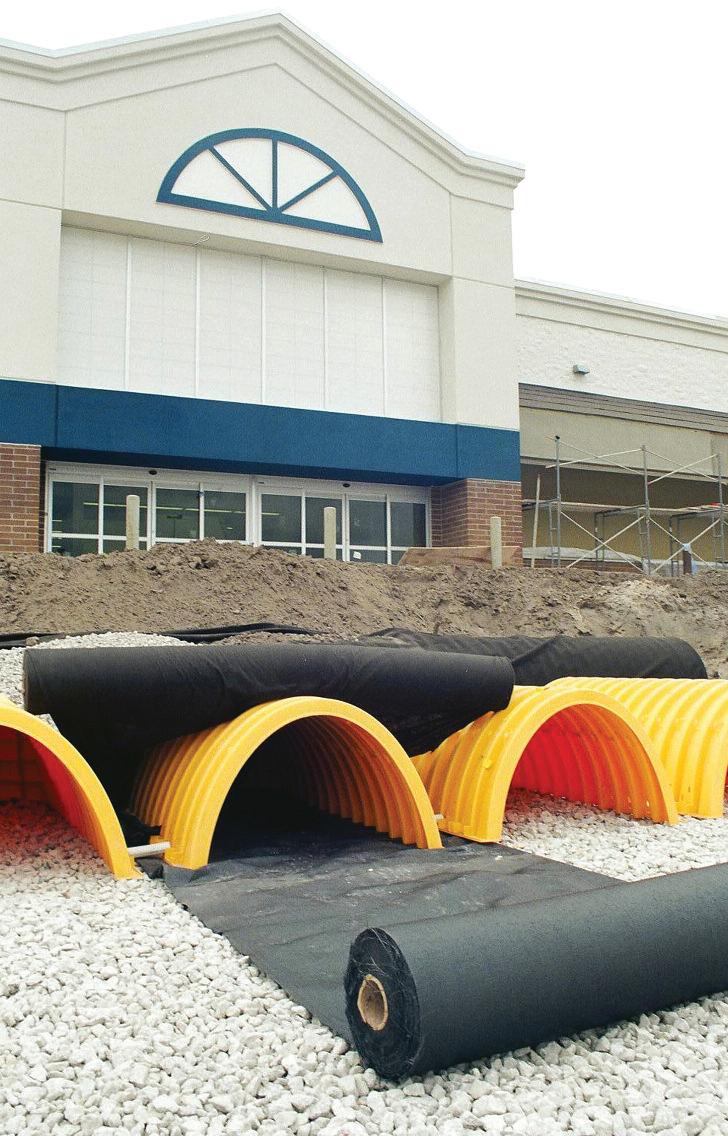
Stuart Crisp, UK Manager of Advanced Drainage Systems (ADS), looks at how ‘good’ SuDS addresses water quality as much as water quantity when it comes to managing water down a ‘treatment train’.
tank Finally, regional control would see a system that could handle run-off from several sites, perhaps resulting in a detention basin or wetland
Risk-based approach


The SuDS Manual, C753, published by CIRIA, prescribes a risk-based approach to designing SuDS for water quality If pollution risks are deemed to be low, then SuDS designers can prioritise water quantity, amenity and biodiversity If they are medium, then all considerations must be balanced And if they are high, water quality evaluation must take precedence It should however be noted that in all cases, including medium and low pollution risk sites, appropriate mitigation should be put in place to reduce the risk of pollution
There is a range of water quality treatment measures that can be included in a SuDS train Sometimes it is possible to use a completely natural SuDS train to deal with both water quantity and quality issues At other times, the best solution combines natural and engineered SuDS elements, or may require proprietary manufactured elements only This could be due to high levels of pollution loading or the space available
WATER MANAGEMENT
The SuDS Manual, C753, published by CIRIA, prescribes a risk-based approach to designing SuDS for water quality
Water pollutants
There are four main types of pollutant that can be found in stormwater run-off: sediments, metals, hydrocarbons and nutrients Sediments, often referred to in pollution mitigation as total suspended solids (TSS), is particulate matter It includes tiny particles of soil, such as silt and clay, which have been dislodged by rainwater as it passes over the run-off surfaces
Metals and metal compounds can be dissolved in run-off or attached to silts and sediments in the water Copper and zinc are most commonly found in surface water in the UK but there can be cadmium and other toxic metals too Although plants require very small amounts of copper and zinc to grow, higher concentrations can be damaging to them
Hydrocarbon pollution comes with runoff from roads, car parks and areas where machines operate and are maintained, due to oil and fuel spills, tyre and brake wear Changing climate means that rainfall events can be further apart but more intense, which can lead to higher concentrations of pollutants from roads, as they build up for longer before being washed away
Nutrient pollution, usually nitrogen or phosphorous based, can come from sources such as run-off from agricultural land where fertiliser has been used or combined sewer overflows (CSOs), where sewage and surface water are mixed and discharged into bodies of water They can lead to algal blooms, which reduces oxygen levels in the water and can negatively impact on aquatic habitats
Capturing TSS pollution should generally be the focus of water treatment strategies in SuDS design since this removes both the solid particles and any pollution clinging to them This can be done using a natural SuDS feature, such as planting for bioretention or a swale
Manufactured components such as filtration devices, silt traps or vortex separators can also be used upstream to remove solids before water is discharged into ponds, for instance
Removal of sediment and solids is also important from a water quantity perspective Build-ups reduce the capacity of a water storage element, whether natural or manufactured How and when to


remove sediment should be considered at the design stage and should be part of a planned maintenance regime
Without a means of reducing suspended solids upstream of an attenuation device, sediment build-up within the device can reduce its efficiency over time Some recently introduced underground archshaped SuDS attenuation devices have their own built-in systems for intercepting solids, which are fast and simple to maintain
Mitigation indices
The SuDS Manual sets out a simple method for dealing with water pollution risks, requiring the determination of pollution hazard indices for the area under consideration and then matching a SuDS device with matching mitigation indices
In Table 26 2, the manual provides pollution hazard indices for a range of applications and for three types of pollution: TSS, metals and hydrocarbons So, for example, for a busy public car park or hospital, the index for TSS is 0 7, for metals is 0 6 and for hydrocarbons 0 7
The next step is to identify a form of SuDS treatment that can provide the necessary mitigation indices, either as a single treatment stage or using a combination of components The manual has a table for that too, Table 26 3 However, this table only provides mitigation indices for natural SuDS components The mitigation indices for the natural SuDS components were compiled by a team of experts, drawing information from a selection of published papers Mitigation indices for proprietary manufactured treatment systems must be
provided by the manufacturer using recognised test methods and third party verified data
British Water has published a Code of Practice for the Assessment of Manufactured Treatment Devices
Designed to Treat Surface Run-off It uses rainfall time-series data for the UK to determine an appropriate treatment flow rates based on first-flush principles and uses a combination of two established test protocols the German Deutsches Institut für Bautechnik (DIBt) and the New Jersey Corporation for Advanced Technology (NJCAT) from the US to create the British Water test methods
In 2022 British Water published a ‘how to’ guide, Applying The CIRIA SuDS Manual (C753) Simple Index Approach To Proprietary/Manufactured Stormwater Treatment Devices, which provides a calculation methodology to derive mitigation indices for TSS, metals and hydrocarbons based on the British Water Code of Practice, or the DIBt or the NJCAT, test results This enables manufacturers of proprietary treatment products to have their mitigation indices published so that they can be considered as part of a SuDS management train
n For more information on Advanced Drainage Systems’ SuDS attenuation components, including a handy Design Tool, Mitigation Indices Data Sheet, Structural Design Technical Note and Installation App or to book a CPD, go to www.rdr.link/lar029

M A Y / J U N E 2 0 2 4 L A B M I 4 9
The SuDS treatment train considers water quality and prevention of pollution from stormwater runoff (alongside flood risk mitigation)
Water pollutants
There are four main types of pollutant that can be found in stormwater run-off: sediments, metals, hydrocarbons and nutrients Sediments, often referred to in pollution mitigation as total suspended solids (TSS), is particulate matter It includes tiny particles of soil, such as silt and clay, which have been dislodged by rainwater as it passes over the run-off surfaces
Metals and metal compounds can be dissolved in run-off or attached to silts and sediments in the water Copper and zinc are most commonly found in surface water in the UK but there can be cadmium and other toxic metals too Although plants require very small amounts of copper and zinc to grow, higher concentrations can be damaging to them
Hydrocarbon pollution comes with runoff from roads, car parks and areas where machines operate and are maintained, due to oil and fuel spills, tyre and brake wear Changing climate means that rainfall events can be further apart but more intense, which can lead to higher concentrations of pollutants from roads, as they build up for longer before being washed away
Nutrient pollution, usually nitrogen or phosphorous based, can come from sources such as run-off from agricultural land where fertiliser has been used or combined sewer overflows (CSOs), where sewage and surface water are mixed and discharged into bodies of water They can lead to algal blooms, which reduces oxygen levels in the water and can negatively impact on aquatic habitats
Capturing TSS pollution should generally be the focus of water treatment strategies in SuDS design since this removes both the solid particles and any pollution clinging to them This can be done using a natural SuDS feature, such as planting for bioretention or a swale
Manufactured components such as filtration devices, silt traps or vortex separators can also be used upstream to remove solids before water is discharged into ponds, for instance
Removal of sediment and solids is also important from a water quantity perspective Build-ups reduce the capacity of a water storage element, whether natural or manufactured How and when to


remove sediment should be considered at the design stage and should be part of a planned maintenance regime
Without a means of reducing suspended solids upstream of an attenuation device, sediment build-up within the device can reduce its efficiency over time Some recently introduced underground archshaped SuDS attenuation devices have their own built-in systems for intercepting solids, which are fast and simple to maintain
Mitigation indices
The SuDS Manual sets out a simple method for dealing with water pollution risks, requiring the determination of pollution hazard indices for the area under consideration and then matching a SuDS device with matching mitigation indices
In Table 26 2, the manual provides pollution hazard indices for a range of applications and for three types of pollution: TSS, metals and hydrocarbons So, for example, for a busy public car park or hospital, the index for TSS is 0 7, for metals is 0 6 and for hydrocarbons 0 7
The next step is to identify a form of SuDS treatment that can provide the necessary mitigation indices, either as a single treatment stage or using a combination of components The manual has a table for that too, Table 26 3 However, this table only provides mitigation indices for natural SuDS components The mitigation indices for the natural SuDS components were compiled by a team of experts, drawing information from a selection of published papers Mitigation indices for proprietary manufactured treatment systems must be
provided by the manufacturer using recognised test methods and third party verified data
British Water has published a Code of Practice for the Assessment of Manufactured Treatment Devices
Designed to Treat Surface Run-off It uses rainfall time-series data for the UK to determine an appropriate treatment flow rates based on first-flush principles and uses a combination of two established test protocols the German Deutsches Institut für Bautechnik (DIBt) and the New Jersey Corporation for Advanced Technology (NJCAT) from the US to create the British Water test methods
In 2022 British Water published a ‘how to’ guide, Applying The CIRIA SuDS Manual (C753) Simple Index Approach To Proprietary/Manufactured Stormwater Treatment Devices, which provides a calculation methodology to derive mitigation indices for TSS, metals and hydrocarbons based on the British Water Code of Practice, or the DIBt or the NJCAT, test results This enables manufacturers of proprietary treatment products to have their mitigation indices published so that they can be considered as part of a SuDS management train
n For more information on Advanced Drainage Systems’ SuDS attenuation components, including a handy Design Tool, Mitigation Indices Data Sheet, Structural Design Technical Note and Installation App or to book a CPD, go to www.rdr.link/lar029

M A Y / J U N E 2 0 2 4 L A B M I 4 9
The SuDS treatment train considers water quality and prevention of pollution from stormwater runoff (alongside flood risk mitigation)
First water positive development Affinity Water, a leading provider of clean water services in the UK, has announced a significant milestone in its innovation journey with the successful creation of the world's first Water positive development in Bidwell, Central Bedfordshire, in collaboration with Independent Water Networks Ltd (IWNL) this marks a significant advancement in the pursuit of water neutrality and sustainable development the company ’ s Water Neutrality project, funded by ofwat, aims to explore innovative approaches to achieving water neutrality in new housing developments the recent achievement in Bidwell showcases the effectiveness of Affinity Water's strategies in enabling growth while protecting the environment one of the key commitments under ofwat's funding rules is the sharing of learning and knowledge across the industry Affinity Water is pleased to report that its project results and learnings are being considered nationally and across the water industry, demonstrating the project's impact and relevance on a broader scale What has been learnt from Bidwell's Water positive development has informed the next steps towards building a

sustainable solution for the medium- to long-term Affinity Water proposes the establishment of a ‘Water trading framework’, allowing households and non-household customers to trade water wastage with housing developers or businesses, aiming to secure high Environmental, Social, and governance (ESg) standards
n More information on the Water Positive development in Bidwell and the company’s Water Neutrality project here www.rdr.link/lar030

Adver tisement index
rdr link/LAR100 Aico Ltd
rdr link/LAR101
AKW Medi-Care
rdr link/LAR102
28)
19)
Andreas Stihl Ltd (page 2 IFC)
www rdr link/LAR103
Astraseal (page 31)
www rdr link/LAR104
BPD/Glidevale (page 32)
www rdr link/LAR105
Geberit/Twyfords ..............................................................(page 23)
www rdr link/LAR106
Henco ................................................................................(page 22)
www rdr link/LAR107
Horne Eng Co Ltd ..............................................................(page 9) www rdr link/LAR108
Mitsubishi Electric Europe/Ecodan ..............................(page 42) www rdr link/LAR109
Panasonic Htg & Cooling ..................................................(page 4) www rdr link/LAR110
ProBuilder Live (page 51/IBC) www rdr link/LAR111
Rockwool UK Ltd (page 24)
www rdr link/LAR112
Samuel Heath & Sons (page 27)
www rdr link/LAR113
Sunray Timber Fire Doors ..............................................(page 37)
www rdr link/LAR114
Wavin Ltd ............................................................................(page 11)
www rdr link/LAR115
WAtER MANAgEMENt RoUNd-Up 5 0 I L A B M M A Y / J U N E 2 0 2 4
adverts that appear in this issue of Local Authority Building & Maintenance Each is listed
page number
URL
get you straight to the relevant online information
www
..............................................................................(page
www
Here is a useful summary of all the
with its
and a direct
that will
A. Proctor Group ................................................................(page 7)
www
................................................................(page






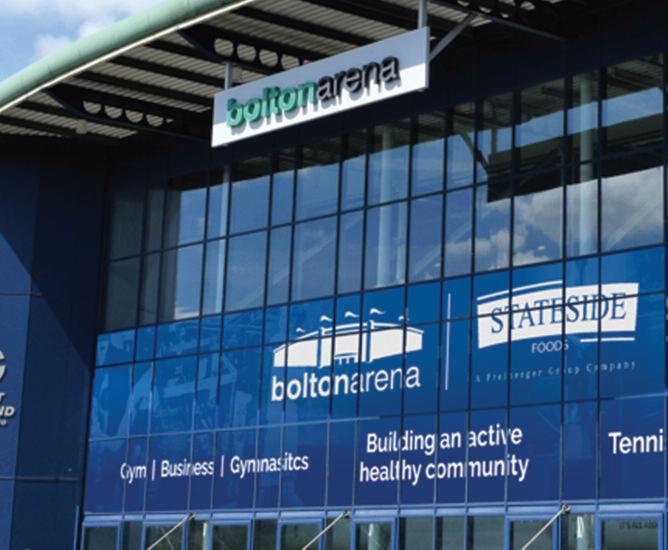
R E G I S T E R F O R F R E E AT W W W. P R O B U I L D E R L I V E . C O. U K T H E R E G I O N A L S H O W S F O R B U I L D I N G P R O F E S S I O N A L S COVERING ALL ASPECTS FROM HEATING AND PLUMBING TO BUILDING AND ELECTRICAL SERVICES ● FREE CPD SEMINARS ON LOW CARBON HEATING, FIRE SAFETY LEGISLATION AND EV CHARGING ● FREE ENTRY ● FREE PARKING FO RT H C O M I N G S H O W S : Professional LIVE! ELEX 2024 PROFESSIONAL ELECTRICIAN The Electricians’ Exhibition Sponsored by CBS ARENA COVENTRY CBS ARENA COVENTRY 12TH & 13TH SEPTEMBER 2024 SANDOWN PARK SURREY SANDOWN PARK SURREY 7TH & 8TH NOVEMBER 2024 BOLTON ARENA BOLTON BOLTON ARENA BOLTON 6TH & 7TH MARCH 2025
F o r a l l t h e l a t e s t n e w s a n d v i e w s c h e c k o u t
l a b m o n l i n e . c o . u k
L O C A L A U T H O R I T Y B U I L D I N G& M A I N T E N A N C E
L A B M ’s w e b s i t e o f f e r s a n e s s e n t i a l i n f o r m a t i o n r e s o u r c e f o r l o c a l a u t h o r i t y a n d h o u s i n g
a s s o c i a t i o n s p e c i f i e r s , a n d a n y o n e i n v o l v e d i n t h e c o n s t r u c t i o n , r e f u r b i s h m e n t a n d
m a i n t e n a n c e o f s o c i a l a n d a f f o r d a b l e h o u s i n g , s c h o o l s , h e a l t h c a r e f a c i l i t i e s
a n d p u b l i c s e c t o r b u i l d i n g s
O n t h e w e b s i t e y o u ’ l l f i n d d e t a i l s o n a l l t h e l a t e s t f u n d i n g a n d r e g u l a t o r y u p d a t e s , s e c t o r a n n o u n c e m e n t s , c o n t r a c t a w a r d s a n d i n d u s t r y e v e n t s We s h a r e i n s i g h t a n d o p i n i o n f r o m
c o m m e n t a t o r s a c r o s s t h e s u p p l y c h a i n , f e a t u r e i n - d e p t h p r o j e c t c a s e s t u d i e s a n d i n o u r
P r o d u c t s s e c t i o n , s h o w c a s e n e w p r o d u c t i n n o v a t i o n s , t e c h n o l o g i e s a n d c o n s t r u c t i o n s o l u t i o n s








D o n ’ t f o r g e t t o f o l l o w u s o n Tw i t t e r @ la b mm a g a n d o n L i n k e d I n a t
w w w li nke d in c o m/ c o mp a ny / lo c al -a u t ho r it y -b u il di ng - m ai nt e na nce f o r a l l t h e l a t e s t s t o r i e s





























 Gavin Board, John Kelly, Mayor Tony Page, Cllr Mohammed Ayub, Cllr Karen Rowland and Mandeep Dhadwal
Project partners on site
Gavin Board, John Kelly, Mayor Tony Page, Cllr Mohammed Ayub, Cllr Karen Rowland and Mandeep Dhadwal
Project partners on site




































 AkzoNobel offers larger, reusable 170L paint containers
AkzoNobel offers larger, reusable 170L paint containers

























































 Low carbon heat is being provided to homes on the Consort, Newington and Wyndham housing estates in Southwark via specially developed water source heat pumps
Low carbon heat is being provided to homes on the Consort, Newington and Wyndham housing estates in Southwark via specially developed water source heat pumps






































